June 30 - July 6, 2013: Issue 117
Ena I, II and III – Steam Yachts
A ‘song of many Enas’ this week’s history page could be termed. Our last for this second round of Pittwater ferries, the many Enas we refer to here, as there were others elsewhere in Brisbane and as yachts that sailed on our own harbour without benefit of a steam engine, were all Steam Yachts named ‘Ena’ that all visited Pitwtater or her offshore areas from at least the 1890s until the 1970’s.
The first was the smallest. The second Ena stayed longest in Pittwater, visiting as a luxury vessel as part of the RSYS’s Easter Cruises to Pittwater in the late 1880’s, whent his was all the rage, returning to become a vessel for Hawkesbury tourist Trades, then to the Port Jackson Steamship Company when they ran so many Pittwater ferries and finally being transferred to the Windybank family of Cowan where she was employed as the Swanhilda in the Palm Beach to Mackerel and Little Mackerel, now know as our beloved Currawong.
Ena III is included because she too visited Pittwater when a bloom was still in her cheek, travelled far and wide, to Tasmania and back, and now, renewed and lifted from her Derwent River grave, plies her trade again on Sydney Harbour as part of our Historic Fleet.
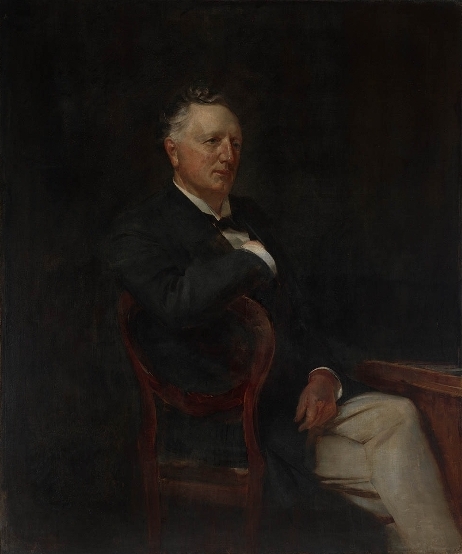 Of the various Enas, the first was built for Mr. George Cheeke, the other two for Sir Thomas Allwright Dibbs and named after his wife Tryphena. Mr Dibbs was a brother of New South Wales Premier Sir George Dibbs, a keen yachtsman and commodore of the Royal Sydney Yacht Squadron for a while. Devout in nature, active in diocesan affairs of the Church of England, his philanthropic interests included the Sydney Naval Home and the Queen Victoria Home for Consumptives. In June 1915 he gave his home, Graythwaite, to the Commonwealth government as a convalescent hospital for wounded soldiers. (1.) He attracted the envy of some and admiration of a greater number.
Of the various Enas, the first was built for Mr. George Cheeke, the other two for Sir Thomas Allwright Dibbs and named after his wife Tryphena. Mr Dibbs was a brother of New South Wales Premier Sir George Dibbs, a keen yachtsman and commodore of the Royal Sydney Yacht Squadron for a while. Devout in nature, active in diocesan affairs of the Church of England, his philanthropic interests included the Sydney Naval Home and the Queen Victoria Home for Consumptives. In June 1915 he gave his home, Graythwaite, to the Commonwealth government as a convalescent hospital for wounded soldiers. (1.) He attracted the envy of some and admiration of a greater number.
DEATH OF SIR T. A. DIBBS. Notable Australian Banker. SYDNEY, Sunday-The death occurred this morning, at his residence, Wolseley road, Point Piper, of Sir Thomas Allwright Dibbs. He was in his 91st year and had been ill for about three weeks. The death of Sir Thomas Dibbs marks the passing of one of Australia's most notable bankers and one whose munificent spirit and public service had been identified with so many benevolent and patriotic movements. The spirit of public service exemplified in many directions by Sir Thomas Dibbs was strikingly manifested by him in co operation with Lady Dibbs in the gift to the authorities of his beautiful home, Graythwaite, North Sydney as a home for disabled soldiers. Sir Thomas Dibbs, who was a son of Captain John Dibbs, of St Andrews, Scotland, and who was educated at the Australian College, Jamieson Street, Sydney, had knighthood conferred upon him in 1917, and of the honours then conferred by the King, none gave more general satisfaction than that bestowed upon the veteran banker and philanthropist. His name will always be associated with the Commercial Banking Company of Sydney, from which he retired in 1915, after 68 years' service, taking a seat on the board of directors on his retirement. Of his long service with the company 48 years were spent as general manager. Sir Thomas Dibbs is survived by Lady Dibbs, who is aged 83 years. Mr Tom Burton Dibbs, the only son, died in Geelong about two years ago. A daughter, Mrs Charlie Gaden, is also dead. Members of the family who are living are Miss Dibbs, Mrs H H Massie, Mrs. Fred Cape, Mrs T Honnor (England), Mrs W Mitchell, and Mrs W Ritchie, of New Zealand. Mrs Burton Dibbs arrived in Sydney from Geelong on Saturday. DEATH OF SIR T. A. DIBBS. (1923, March 19). The Argus(Melbourne, Vic. : 1848 - 1957), p. 10. Retrieved from http://nla.gov.au/nla.news-article1883838
Above: Portrait of Sir Thomas Allwright Dibbs, 1897 / painted by Tom Roberts. A plaque originally at lower centre read "Presented to Thomas Allwright Dibbs General Manager of the Commercial Banking Company of Sydney Ltd. By The Officers of the Bank in Commemoration of the Completion of his Fiftieth year of Service in the Institution 7th July 1897" Formerly hung at Graythwaite, home of Sir Thomas and Lady Dibbs until 1915, when it became a nursing home. Album ID : 874522, courtesy State Library of NSW.
We first were inspired to find out more about this Ena during easter this year while looking at Easter's past in Easter Cruises in Pittwater - from 1893 - a small insight into the love of sailing in Sydney's formative years and how all came here, to Pittwater. This Ena was Ena II, the version that became a Pittwater ferry:
AQUATICS. EASTER CRUISE. The fine weather is evidently inducing a huge number of " campers-out " this year than hitherto. During yesterday evening numbers of craft, from the stately yacht to the miniature canvas dingy, could be seen making their way down the harbour to the various nooks and corners which abound in Middle Harbour, North Harbour, Vaucluse, &c. Several of the larger yachts, including the White Star, Ena, Iduna, Thelma, and Ess, got under weigh yesterday. The Ises and others will follow during the morning, all bound for Broken Bay. Refuge Bay and the Basin will no doubt be the favoured spots chosen by the yachtsmen. The steam yacht Isis will no doubt be in evidence, her favourite spot being Evening Bay, on the eastern shores of Pittwater. The Ena will no doubt be found in Coal and Candle Creek, a tributary of Cowan. Apparently there is plenty of fishing to be had according to report, so that the next few days, provided it remains fine, should be spent very pleasantly. AQUATICS. (1896, April 3). The Sydney Morning Herald (NSW : 1842 - 1954), p. 3. Retrieved from http://nla.gov.au/nla.news-article14044107
Steam Yachts were the luxury vessels of their day:
The term "steam yacht" encompasses vessels of two distinct uses, but of similar design. The first is a luxury yacht in the modern sense—a vessel owned privately and used for pleasure or non-commercial purposes. Steam yachts of this type came to prominence from the 1840s to the early-20th century in Europe. The first British royal yacht was Victoria and Albert of 1843. The first in the USA, Vanderbilt's steam yacht North Star, was from 1854: steam yachts were commissioned by wealthy individuals and often heads of state as extravagant symbols of wealth and/or power. They were usually built with similar hull-lines to clipper ships, with an ornate bow structure and a low, smooth freeboard. Main propulsion usually came from one or two steam engines, later of compound type, or in even later, very large yachts, triple expansion or turbines. Steam yachts usually carried rigging for sails, originally as an auxiliary propulsion system, but later more for show and naval tradition. Private steam yachts were capable of long seagoing voyages. In the First World War vessels such as these and several requisitioned private yachts were used on anti-U-Boat patrols and for minesweeping. It became clear that the naval trawler was more suited to these kinds of tasks. Steam yachts often used the ship prefix SY, but some were alternatively described as screw schooner, if they carried schooner rig. Steam yacht. (2013, April 3). In Wikipedia, The Free Encyclopedia. Retrieved fromhttp://en.wikipedia.org/w/index.php?title=Steam_yacht&oldid=548404250
Ena I
We cannot categorically state that this first vessel named Ena, that was a steam yacht and owned by T A Dibbs, is the one reported to have sunk off Broken Bay, or Newcastle in April 1890. despite trying to track down an image of her for months, she remains elusive. We have only her dimensions and mentiosn to go by:
STEAM PLEASURE Yacht ENA, for Hire daily; moderate rates. Orders left at MITCHELL and CO.'S, Circular Quay. Advertising. (1878, November 2). The Sydney Morning Herald(NSW : 1842 - 1954), p. 1. Retrieved from http://nla.gov.au/nla.news-article13415064
PLEASURE STEAM YACHT, 10 knots, carrying 12 passengers. GILCHRIST, STUBBS, and WESTON. And in same notices: STEAM Pleasure Yacht ENA, for Hire daily ; moderate. Orders left at MITCHELL and CO.'S, Circular Quay. Advertising. (1878, November 16). The Sydney Morning Herald(NSW : 1842 - 1954), p. 1. Retrieved from http://nla.gov.au/nla.news-article13412657
STEAM PLEASURE YACHT ENA for Private SALE or HIRE, at reduced rates. Orders left at Mitchell and Co.'s. Advertising. (1879, May 13). The Sydney Morning Herald (NSW : 1842 - 1954), p. 1. Retrieved from http://nla.gov.au/nla.news-article13434489
SCREW STEAM YACHT ENA The most handsome and most comfortable Yachting steamer in the colony. The most economical Steamer afloat, compound engines steams 10 knots Fitted with every requisite. GILCHRIST, STUBBS, and WESTON have received instructions to sell by auction, at the Rooms, 273, George street, on TUESDAY, 13th August, at 11 o'clock, The above very handsome, comfortable, and economical steam screw-yacht ENA eight-horse power nominal, compound engines, small consumption, all requisite fittings for harbour or sea going. The most perfect steam-yacht In the colony. Orders to view can be had of the Auctioneers GILCHRIST STUBBS, and-WESTON. Advertising. (1878, August 8). The Sydney Morning Herald(NSW : 1842 - 1954), p. 7. Retrieved fromhttp://nla.gov.au/nla.news-article13414107
SCREW STEAM-YACHT ENA, 50 FEET LONG, 9 FEET BEAM, steams about 10 KNOTS comfortably. Fitted with CABIN and every requisite for a pleasure-going craft INSIDE or OUTSIDE the HEADS. GILCHRIST, STUBBS, and WESTON are instructed to sell by auction, at the ROOMS, 273, GEORGE-WREET,THIS DAY, 29th OCTOBER, at 11 a.m..The BEST and most economical little vessel in the harbour, with the handsomest COMPOUND ENGINES, SMALL CONSUMPTION, FRESH or SALT WATER as convenient. In first-class order, and nothing wanting. SSS' Sale. TUESDAY, 29th October, at 11 a.m.GILCHRIST, STUBBS, and WESTON, Auctioneers.Advertising. (1878, October 29). The Sydney Morning Herald(NSW : 1842 - 1954), p. 10. Retrieved from http://nla.gov.au/nla.news-article13421422
STEAM PLEASURE YACHT ENA for Private SALE or HIRE, at reduced rates Orders left at Mitchell and Co 's Advertising. (1879, June 19). The Sydney Morning Herald(NSW : 1842 - 1954), p. 1. Retrieved from http://nla.gov.au/nla.news-article13436920
THE INTERCOLONIAL EIGHT-OAR RACE. The Intercolonial Eight-oar Race for 1881 took places on Saturday afternoon, with the result that for the first time the Victorians have scored a win upon the Parramatta River, and that for the third of the four occasions upon which the race has taken place, New South Wales has been shown the way over the course, and this time from start to finish. We shall probably have this result explained in a variety of ways, but the reasonable, explanation appears to us to be that Ino Victorian crew were better men than ours, and that their superiority, arose from their having been trained together longer and more carefully than our men were.
At 4 o'clock the starting point at Ryde was a busy scene. The Commodore, the Prince of Wales, the Telephone, the Government steamer Achilles, the police launch, the Ena, and the Governor's launch Nea, were assembled there. The Nea ecarried Lord and Lady Augustus Loftus, Lieutenant A. D. Loftus, A.D.C. ; Mr. Reginald Bloxsome, private secretary. A boat, manned by patients from the Gladesville Asylum, attracted some attention, but their demeanor was quiet, indeed apathetic, and the only lunatic behaviour displayed was upon the steamers later on. SPORTING INTELLIGENGE. (1881, April 11). The Sydney Morning Herald (NSW : 1842 - 1954), p. 6. Retrieved from http://nla.gov.au/nla.news-article13477382
Her undoing is courtesy of the Encyclopedia of Australian Shipwrecks:
Ena. Wooden ketch, 11 tons. #75004. Built NSW, 1878; reg. Sydney, 37/1879. Length 44 ft. Lost north of Broken Bay, NSW, 24 March 1890. [SAN]
Loney lists: Ena. Steamship, 11 tons. Driven from moorings at Newcastle during a gale and apparently foundered, 2 April 1890. [LN]
The Steamer Ena Adrift. The Harbors-and Rivers Department received, the following telegram from Broken Bay from Captain Harding, of the Government steamer Beah, on Wednesday : ' The steamer Beah with the Government steamer Ena in tow left Newcastle for the Richmond River on Friday afternoon last, and when off Crowdy Heads a N.E. gale was experienced; turned back intending to make Port Stephens but was unable to do so. The steamer then stood on for Newcastle. Just before making Newcastle the tow line parted, and the Ena was no more seen. After a search, which proved in vain, the Beah made for Broken Bay, and arrived there at 1p.m. on Tuesday. The Beah left Broken Bay on Wednesday to make search, proceeding northward. The Ena is a wooden steamer of 11 tons gross and 8 tons net, built at Sydney in 1879. Her dimensions are Length 47ft, with a beam of 9ft 1in, and depth of hold 4ft 4in. The Steamer Ena Adrift. (1890, March 27). Evening News (Sydney, NSW : 1869 - 1931), p. 6. Retrieved from http://nla.gov.au/nla.news-article108803730
The Government steamer Ena broke adrift during the gale whilst being towed to Richmond River. Although search has been made no trace of her can be found. LATEST SPECIAL TELEGRAMS. (1890, March 27). The Maitland Mercury & Hunter River General Advertiser(NSW : 1843 - 1893), p. 5. Retrieved from http://nla.gov.au/nla.news-article18981859
Ena II
A very successful trial of a new steam yacht, built for Mr. Dibbs, Manager of the Commercial Bank, took place last Saturday The yacht, which is named Ena, is the finest of her kind in Australia. LATEST SPECIAL TELEGRAMS. (1883, September 25). The Maitland Mercury & Hunter River General Advertiser (NSW : 1843 - 1893), p. 5. Retrieved from http://nla.gov.au/nla.news-article907707
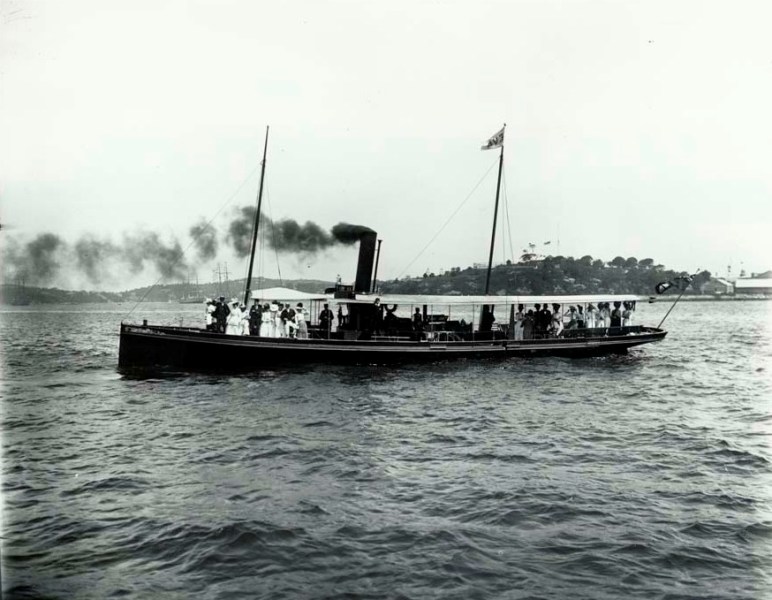
NEW STEAM YACHT. New steam yacht, built for Mr. T.A. Dibbs, manager of the Commercial Sank, has been named the Ena, is the finest of the kind in Australia. She is capable of running in harbour waters at a speed of 11 knots an hour ; is fitted with' a special sleeping-cabin for ladies, sleeping accommodation for gentlemen, conking apparatus, and dining accommodation. A pleasure party of 30 or 40 persons could live on board for days at a stretch with the utmost convenience and comfort. She is 53 tons, fitted with engines of 70 horsepower nominal, and as the deck is free of encumbrance there is a clear promenade of over 100 feet round the vessel. In forepart is a very handsome cabin panelled with walnut of bird's-eye maple, with pier-glass and marble-top sideboard, velvet cushioned seats, carpeted floor, and convenient lookers, and covered by skylights of frosted and coloured glass, and all the motal fastenings nickel-plated. In the centre of the cabin is a Mason and Hamlin organ so that in the daytime this cabin can be made an agreeable social resort. At nighttime, if there should be ladies on board, it will be made a ladies cabin only. The seats can be readily transformed into comfortable beds, while beds can be placed alongside centre of the cabin between the seats, and in this way eight or nine ladies can be provided for. Amidships are the engine-house and cooking apparatus, the latter being specially suited for such a craft as this, and aft is a fine deck with an open " well " in the centre. In this " well" is placed the dining table with fixed seats for 15 or 20 around it; and underneath the deck is n pantry in which are stored the supplies, crockery, cutlery, &c. Over this part of the deck is a fixed open awning of cedar planks, braced with elm and at night time the whole of the after part of the vessel can be transformed into a cosy room 40 feet in length and 12in width, by running canvas around from the deck to the awning. Several gentlemen can sleep with comfort in the " well'' and others will sleep on the deck, and for this purpose admirable beds of cork, covered with waterproof and having air pillows attached, are provided. The deck is of 2 1/2 inch Kauri pine; she is 83 feet long, with 12 foot 6 inches beam, the keelson is one piece of ironback to she is planked with Kauri pine and copper-fastened throughout, was built, under Mr. Dibbs' supervision, by Mr William Dunn, of Berry's Bay. NEW STEAM YACHT. (1883, October 3). The Bega Gazette and Eden District or Southern Coast Advertiser (NSW : 1865 - 1899), p. 4. Retrieved fromhttp://nla.gov.au/nla.news-article110304442
The rendezvous was in Farm Cove, and nine yachts assembled there at 1 o'clock under the command of Commodore Knox and Vice-commodore Milson. The yachts were the Sirocco, Waitangi, Guinevere, Daphne, Doris, Mabel, Pleiades, Oithoua, and Mr. T. A. Dibbs's new steam yacht Ena. At this juncture a description of the latest addition to the vessels of the club, and the first steam yacht which has joined a club in Australia will no doubt prove Interesting. The NEW STEAM YACHT ENA, which made her first official appearance under the flag of the R.S.Y.S. on Saturday, is the property of Mr. T. A, Dibbs, manager of the Commercial Bank, and is one of the finest of her class in the colonies. As a specimen of workmanship, she is throughout a credit alike to her designer and builder; and she was built by Mr. William Dunn, of Berry's Bay, under the supervision of Mr. Dibbs. She is a vessel of 53 tons, 82ft in length, with a beam of 12ft 6in. The engines are 70 horse-power nominal, certified to carry 1001b of steam, and were supplied by Pleaty and Son, England. She is built on beautiful lines, copper fastened throughout, with deck planking of 2 ½ in Kauri pine. Although not quite finished, she has had one or two trials, and readily ran up to a speed of 11 knots. Her fittings are very handsome and substantial. Forward is a very fine saloon cabin, lined with walnut, panelled with bird's eye maple, which has a charming effect, also fitted with pier glasses, marble top sideboard, velvet cushioned seats, plenty of lockers, a Mason and Hamlin organ, lavatory, and everything most convenient in fact, throughout tho vessel there is not an inch of room lost. In this apartment there is ample room for sleeping accommodation for 10 ladies, and all the necessary bedding is contained in the lockers. Amidships are the engine house and cooking gallery. On the after deck is a "well" in which are fitted tables and seats capable of accommodating 20 persons, and at tho forward end or the "well" is the pantry and store-room, also supplied with every convenience. Over the after deck is an awning of cedar planks, braced with elm, and at night the whole of the after deck can be covered in at the sides with canvas, thereby giving a comfortable room 40 x 12, while there is a clear deck promenade of 100ft. Altogether she is a very nice vessel, has already proved herself a thorough good sea boat, and is in every way a great acquisition to the club fleet. ROYAL SYDNEY YACHT SQUADRON. (1883, October 13).Australian Town and Country Journal (NSW : 1870 - 1907), p. 35. Retrieved from http://nla.gov.au/nla.news-article71004507
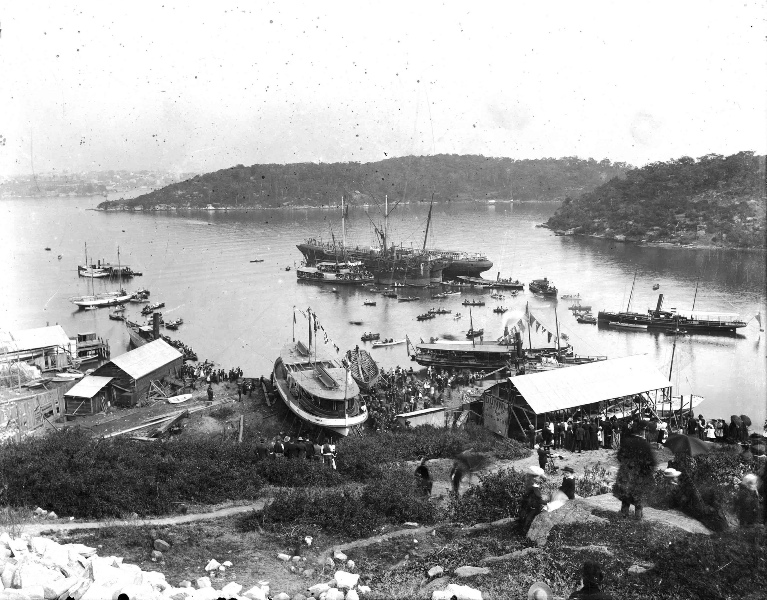
Above: The launch of the Lady Mary at Berry's Bay. Over on the right of the photo is the steam launch Ena being fitted out. Courtesy Australian National Maritime Musueum, image ANMS1902 on flickr. Circa 1883.
Earl and Countess of Rosebery. At the invitation of the Government the Earl and Countess of Rosebery paid a visit to the Hawkesbury. They were accompanied by His Excellency the Governor and Lady Loftus. Sir William and Lady De Voenx, Mr. Eustace Smith (member of the House of Commons for Tynemouth), Mrs. and Miss Smith, the Hon. A. Stuart and Mrs. Stuart, the Hon. W. B. Dalley, the Hon. J. P. Abbott and Mrs. Abbott, the Hon. G. R. Dibbs, the Hon. E. Barton, Professor and Mrs. Badham, Mr. M'Quade, M.L.A., and several others. The party left Sydney at an early hour by steam launch for Manly. They drove from Manly to Pittwater where they embarked on board Mr. Thomas Dibbs's steam yacht Ena, and proceeded up the river to Wiseman's Ferry. They will return to Sydney this evening by train from Windsor. Earl and Countess of Rosebery. (1883, November 26).Evening News(Sydney, NSW : 1869 - 1931), p. 3. Retrieved May 28, 2013, from http://nla.gov.au/nla.news-article108833047
See: http://en.wikipedia.org/wiki/Hannah_Primrose,_Countess_of_Rosebery
ARRIVAL OF BISHOP BARRY AT SYDNEY. By Telegraph. Sydney, April 6. The Eight Rev. Dr. Barry, the new Bishop of Sydney and Primate of Australia, arrivedat Sydney on Saturday morning by the s.s. Valetta, which entered the Heads about 10 o' clock. The steamer arrived somewhat earlier than was anticipated, but all the necessary arrangements for the reception of the Bishop had been made and were most complete, so that no delay occurred. At 9 o'clock a.m. the members of the Standing Committee and the members of the Chapter proceeded down the harbour in Mr. Thomas A. Dibbs's steam-yacht Ena. There were on board the Very Rev. the Dean, Sir Alfred Stephen, Messrs. Alex. Stuart, and George R. Dibbs, and other gentlemen. The steamer Port Jackson followed, conveying the clergy and members of the Synod. The Valetta brought-to near Shark Island and the occupants of the first-named boat then went onboard and accorded the new Bishop a cordial reception. A few minutes afterwards Bishop Barry with his wife and family went on board the yacht Ena and the return trip was made. Upon arrival at Prince's Wharf, where alarge crowd had gathered, the partywas greeted with hearty cheers. The cheers were repeated after the Bishop had entered the Governor's carriage, which was in waiting to ; convey him to the vice-regal residence, where he arrived at about 11 a.m. In the afternoon at 3 o'clock a thanksgiving service was held in St. Andrew’s Cathedral, which was crowded. Among those present were the Bishop of Goulburn and the Bishop of Bathurst. The service was of a most impressive character. Special arrangements had been made for musical accompaniments to the vocal portion of the service, and the improvement was marked. In the general thanksgiving the following words were introduced — ' Particularly to the Bishop of this Diocese and his family, who now desire to offer up their praises and thanksgivings for the mercies vouchsafed to them in their voyage, now happily ended, and to us Thy servants in sending him to preside over us, and Thy Hock entrusted to hi3 oversight as Bishop Bishop Barry preached the sermon, taking for his text part of the first verse 11th chapter 2nd Corinthians,' Workers together with him.' The right Rev. gentleman delivered a most eloquent and, practical address, in which' he made reference to the death of Prince Leopold. ARRIVAL OF BISHOP BARRY AT SYDNEY. (1884, April 7).South Australian Register (Adelaide, SA : 1839 - 1900), p. 5. Retrieved May 28, 2013, fromhttp://nla.gov.au/nla.news-article43659547
Lord Carrington embarked at Man-of-War Stairs on board of the Royal Sydney steam-yacht Ena, escorted by a large number of the beet boats of our amateur nautical fleet. His Excellency was attended by his private secretary and all his aide-de-camp. The guard - boats of the Naval Brigade "tossed oars "in salute as his lordship put his foot on Princess stairs at 3.15 p.m. OFFICIAL LANDING OF LORD CARINGTON. (1885, December 14). The South Australian Advertiser (Adelaide, SA : 1858 - 1889), p. 5. Retrieved May 30, 2013, fromhttp://nla.gov.au/nla.news-article36319066
Lord Carrington's Arrival in Sydney. [BY ELECTRIC TELEGRAPH.][FROM OUR OWN CORREAPONDENT.]SYDNEY, December 11.
THE P. and O. Company's R.M.S. Carthage arrived this morning. His Excellency Lord Carrington, the Hon. Lady Carrington and family, are now at Government House. The steamer was signalled six miles off the Heads atten minutes past 9 this morning, and the Hon. J. R. Dibbs, Premier and Colonial Treasurer, accompanied by Mr. Critchett Walker, principal Under Secretary, Captain Hixson, President of the Marine Board, and Mr. Weir, local agent of the P. and O. Company, left in the steam yacht Ena, and met the Carthage two miles outside the Heads. When the steamer had entered the west channel the Ena ran alongside, and the party went on board the Carthage, and Mr. Dibbs, and those who accompanied him, were introduced to Lord and Lady Carrington. The steamer proceeded up the harbour, and moored at the Nelson's buoy. The vice-regal party then left the Carthage for the Government steam yacht Ena(I), which conveyed them to the landing-place near Fort Macquarie, whence they walked to Government House. Lord Carrington's Arrival in Sydney. (1885, December 19). The Queenslander (Brisbane, Qld. : 1866 - 1939), p. 986. Retrieved May 30, 2013, from http://nla.gov.au/nla.news-article19802240
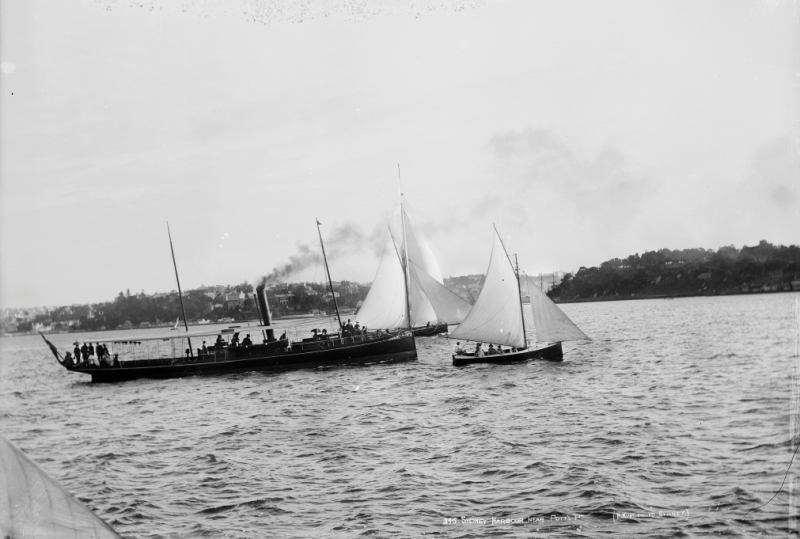
Ena II on Sydney Harbour 1890's. Kerry Image Courtesy Powerhouse Museum Tyrell Collection on Flickr.
Sydney, December 13.The official landing of Lord Carrington took place on Saturday. His Excellency with Lady Carrington left Government House at 2.30 and embarked aboard the steam yacht Ena. After cruising round the harbour the Ena steamed up to Circular Quay, gaily decked with bunting. On passing the Opal and Wolverine His Excellency received a royal salute. Many thousands gathered in the vicinity of Circular Quay, and the whole route from thence to Government House gates was lined with the permanent and volunteer artillery. On stepping ashore Lord Carrington was greeted with enthusiastic, cheers from the assembled thousands. Amongst those present on the jetty were members of the Government, the President of the Council, the Speaker of the Assembly, the members of both houses of the Legislature, and the Mayor and aldermen. His Excellency was met by the Mayor, who presented an address of welcome. Lord Carrington and party then entered a barouche, and beaded the procession to Government House. His Excellency and Lady Carrington were enthusiastically cheered the whole way. The oaths of office were administered in the large hall of Government House, in the presence of a brilliant assemblage. In the evening the members of the volunteer and fire brigade, numbering several hundreds, held a torchlight procession, and marched to Government House, where they presented an address of welcome. INTERCOLONIAL TELEGRAMS. (1885, December 19). The Capricornian (Rockhampton, Qld : 1875 - 1929), p. 4. Retrieved from http://nla.gov.au/nla.news-article67954718
Vice-commodore A. G. Milson (Waitangi), Mr. -Alfred Fairfax, and Mri W. J. Trickott. Among tho.se present were Mr. T. Knox (Sirocco), Mr. J. P. Fitabardingo. (Electra),' Mr. J.'Gilchrist'(Meteor), Mr; D. Wilkins (Daphne), Mr. F. B. Lark (Pleiades), Mr; G. Fi Murnih (Assegai), Mr. AV. B. Mitchell'.(Doris), Mr. Jnlin Young (Alva), Mr: T. A. Dibbs (Ena, steamer), Mr.W. Laidley (Peri), Mr. Jackson (Violet), Mr. A. Oliver (Possum), The ROYAL SYDNEY YACHT SQUADRON. (1886, February 8). The Sydney Morning Herald (NSW : 1842 - 1954), p. 5. Retrieved from http://nla.gov.au/nla.news-article28360416
Referring to yachting we will begin with the premier club, the Royal Sydney Yacht Squadron. It was brought into existence at a meeting hold on the 8th of July, 1862, with a membership list comprising 10 yacht owners. At present there are about 112 members in the club, representing 29 yachts. The term yacht must of course be accepted in a comprehensive sense, as it really includes a steamer, a Schooner, cutters, and yawls. In some cases the tonnage of the barks is large enough to enable them to take long-distance voyages. For instance, the Lady Aline, steamer, which heads the list, ís of 197 tons burthen ; the Red Gauntlet, schooner, 75 tons; the Ena, steamer, 58 tons ; the Northumbria, steamer, 87 tons ; the Mistral, cutter, 82 tons ; the Magic, cutter, 25 tons ; the Waitangi, cutter, 21 tons ;AQUATICS. (1886, March 16). The Sydney Morning Herald (NSW : 1842 - 1954), p. 6 Supplement: Colonial and Indian Exhibition Supplement. Retrieved from http://nla.gov.au/nla.news-article13614265
The steam yacht Isis will no doubt be in evidence, her favourite spot being Evening Bay, on the eastern shores of Pittwater. The Ena (a.) will no doubt be found in Coal and Candle Creek, a tributary of Cowan. Apparently there is plenty of fishing to be had according to report, so that the next few days, provided it remains fine, should be spent very pleasantly. EASTER CRUISE. AQUATICS. (1896, April 3). The Sydney Morning Herald (NSW : 1842 - 1954), p. 3. Retrieved May from http://nla.gov.au/nla.news-article14044107
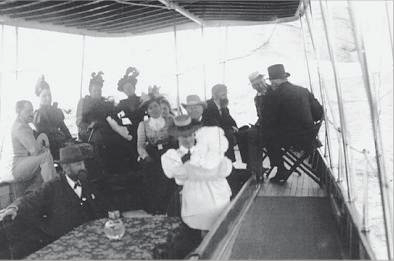 Photo at right, title: 'On Board Sir Thomas A. Dibbs's Ena, circa 1890's. Thomas A. Browne ('Rolf Boldrewood') seated at table, lower left; Winifred Mitchell (nee Dibbs) in white collar, and T.A.Dibbs in grey hat, at centre." From The Nowhere Place by Roger Dunlop. NB: Winifred was married to Walter Dibbs in 1904 and had a daughter Grace later that year. Thus the Ena II was held onto by T.A. Dibbs even after the launch of Ena III until at least 1904.
Photo at right, title: 'On Board Sir Thomas A. Dibbs's Ena, circa 1890's. Thomas A. Browne ('Rolf Boldrewood') seated at table, lower left; Winifred Mitchell (nee Dibbs) in white collar, and T.A.Dibbs in grey hat, at centre." From The Nowhere Place by Roger Dunlop. NB: Winifred was married to Walter Dibbs in 1904 and had a daughter Grace later that year. Thus the Ena II was held onto by T.A. Dibbs even after the launch of Ena III until at least 1904.
AQUATICS Intercolonial Boat-race.(S. M. Herald, 30th May.)THE RACE. At about 3.30 p.m. Mr. T.A. Dibbs's steam yacht Ena, having the umpire (Mr. E.P.Simpson), starter (Mr. W.J. Trickett, M.L.A.), official timekeeper (Mr. J.N. Outlay), representatives of the Press, and a party of ladies and gentlemen on board, arrived off Charity Point, in order to follow the race to the finish.AQUATICS. (1887, June 11). The Queenslander (Brisbane, Qld. : 1866 - 1939), p. 936. Retrieved from http://nla.gov.au/nla.news-article19925389
There are some reports that the brothers Dibb's had a few falling outs, like any family, during their lifetime. This may have been the cause of one of them and also shows an insight into making an example of someone closely connected with the then Premier of NSW:
When it is remembered that in 1885 the Dibbs Government gave the Marine Board power to limit the number of steamers following boat races on the Parramatta River, it seems rather an anomaly that Sir George Richard Dibbs, Sir Frederick Darley, and others in high places should be allowed to set such regulations at defiance. Yet such was the case on Saturday. The steamers Thetis and Birkenhead were the only boats authorized by the Marine Board to follow the race, but the Bronzewing, Ena, and Government steam launch Nea also " chipped in," and as this is not the first time this has occurred some action should be taken in the matter. The Marine Board ought to be no respecter of persons, and should see that their regulations are rigidly enforced. Sporting Echoes of the Week. (1893, May 20). Illustrated Sydney News (NSW : 1853 - 1872), p. 14. Retrieved from http://nla.gov.au/nla.news-article64033429
Walter Watson, the owner of a steamer (unnamed), was similarly charged with infringing the Marine Board Regulations. 'Ho was fined £10, with costs £2 7s. 6d., or one month’s imprisonment. It was alleged that Mr. Watson was on board his steamer and followed the race in her. Messrs. Wallace and Lowe appealed for the prosecution. Mr. T. A. Dibbs, owner of the steam yacht Ena
(which was used as the press and umpire's boat on the, occasion of the Intercolonial Eight-oar Races, was summoned by Inspector Isaac Lee, of the Marine Board, for infringing the " Regulations for bont races and regattas," to wit, by following the aforesaid Intercolonial Eight-oar Race on the 28th May. Messrs. Wallace and Lowe appeared for the Marine Board. Inspector Leo stated that the steamers Admiral and Inflexible wore the only boats allowed to followthe race, and the Ena was unauthorised to follow. Robert A. Keddio said that he formed one of the deputation which waited on the Colonial Treasurer about the matter of an umpire’s boat being allowed to follow the eight-oar race ; they received permission to follow from the Colonial Treasurer in writing ; subsequently he heard the Marine Board objected to the Ena following the race; he did not inform the defendant of this, because the Hon .George Thornton gave a written authority to follow the race. Thomns A. Dibbs stated that on the Thursday preceding the race he received a communication in writing from the New South Wales Rowing Association, asking if he would permit his steam yacht to carry the umpires, the starter, and the press, and stating that they had received permission to follow the race; Inspector Leo came up to the Ena on two occasions and did not warn witness to the contrary. Mr. Dibbs made a statement in which he said he thought his yacht was as much entitled to follow the race(he having received permission from one of the Ministers)as the-yacht Premier, with his Excellency the Governor onboard. ' Mr. Fisher reminded the defendant that the Premier was a Government vessel, and that, therefore, the provisions of the Act did not apply to her. The Bench imposed a fine of £5, with costs, £2 7s 6d, Defendant said he would appeal against the decision. POLICE. (1887, June 14). The Sydney Morning Herald (NSW : 1842 - 1954), p. 3. Retrieved from http://nla.gov.au/nla.news-article13654021
Arrival of New GOVERNOR Lord Hampden. The Yachts. The Hon. E. H. D. White, commodore of the Royal Sydney Yacht Squadron, arranged a yachting demonstration in His Excellency's honour. At ten o'clock the yachts assembled off Port Denison, and proceeded down the harbour to meet the Himalaya. Shortly after the big mailboat was moored the squadron anchored in two lines under the direction of the commodore. The following yachts took part in the demonstration : — White Star, steam yacht, 107 tons, Hon. E. II. D. White ; Bronzewing, steam yacht, 40 tons, Mr. S. Hordern ; Isis, steam yacht, 74- tons, Mr. J. E. Fairfax ; Ena, steam yacht, 56 tons, Mr. T. A. Dibbs Ada, steam yacht, 15 tons, Mr. S. A. Joseph; son ; Era, yawl, 56 tons, Mr. A. G. Mil son ; Thelma, yawl, 23 tons, Dr. MacCormick ; Violet, 12 tons, Mr. F. J. Jackson ; Sirocco, 12 tons, Hon. E. W. Knox ; Lahloo, 5 tons, Mr. W. H. Murrell Bronzewing, 2£-rater, Mr. H M. Cockshot. The streets were crowded with thousands of persons all anxious to get a glimpse of their new Governor. The utmost enthusiasm prevailed, and his Excellency was kept busy acknowledging the cheers, waving of handkerchiefs, and the many expressions of welcome which greeted him on every side. Owing to the perfect arrangements made by the police and transit officials, there was no confusion, and as is usual in our crowds there was an utter absence of any rowdyism. The Proceedings. (1895, November 23). The Catholic Press (NSW : 1895 - 1942), p. 15. Retrieved from http://nla.gov.au/nla.news-article104409747
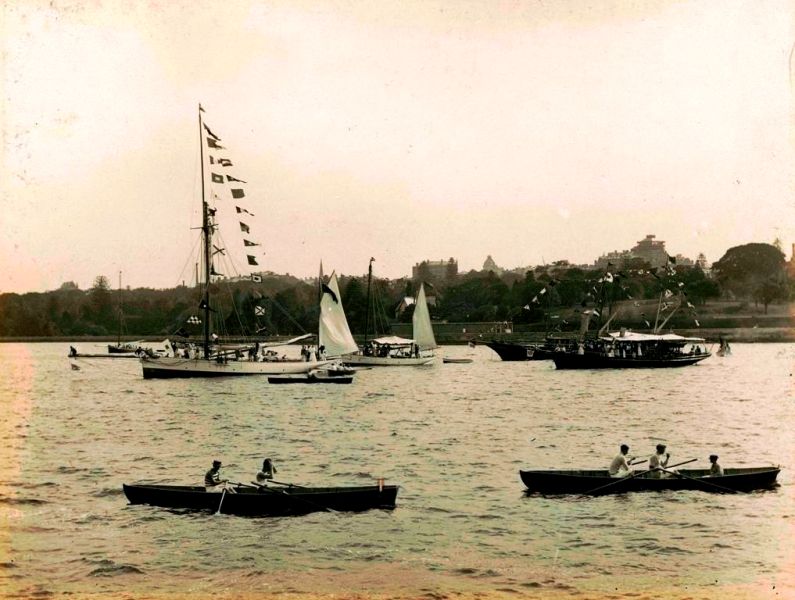
Ena II, Alathea and Bronzewing at PAYC Regatta, circa 1895.
A sailing race under the auspices of the recently formed Newcastle and Hunter River Sailing Club took place in the presence of a large gathering of spectators this afternoon The following boats, all 22-footers, started -Harveoter (W Trost), Rosetta (G Tord), Nellie (C Trolvan), ISautilus (R Hughos), ßreUeni(l Jordan), Irene (II Irelvan), Stiaud (C laitj Champion (R M'Cracken), Ade- laide (R llickoj, juu ) lhe courso was from No 2 timber wharf round No I buoy, then round the black beacon off Stockton, thence inside North Harbor buoy, and around a boat off the south-east end of the dike twice over, then mound No 2 buoy, and back to starting place … The results were -Rosetta, 1 Bredena, 2, Strand, 3. Han ester, 1 The event was won easily by it quarter of a mile The second place was secured with 100 yards to spare, a similar distance separating the third and fourth. … The steamer Ena followed the race, and was largely patronised The officials wero -Commodore, W P Lauco, umpire, A Minor, judge J Lane, 6tarter, R Frost, hon secretary, ii. Hickey, jun THE QUESTION OF GASEOUS MINES. (1899, February 10). The Sydney Morning Herald (NSW : 1842 - 1954), p. 6. Retrieved from http://nla.gov.au/nla.news-article14199637
The Ena II became part of the Hawkesbury Tourist Bureau fleet from this time and when they were bought by the Port Jackson Steamship Company she became of their fleet. From there she made her way into the hands of the Windybank family who needed a replacement vessel for their larger Gloria, which was requisitioned by the RAN for war service in New Guinea, once again, during WWII and eventually sunk there by Japanese forces.
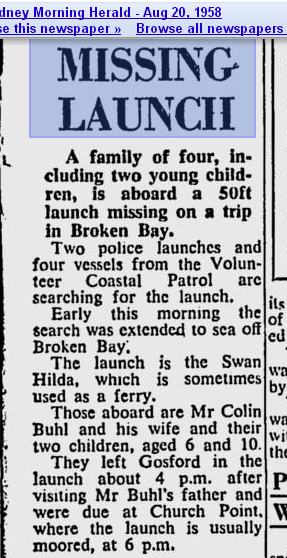 Ena II becomes Swanhilda
Ena II becomes Swanhilda
I can remember catching the double decker bus from Wynyard for the 1 hr trip to the Palm Beach wharf with dad and his best mate Ted Bunn. The old ferry wharf was further south than the existing one and close to a small grocery store that I think now may (or may have been) a bottle shop and the ferry was the 'Swanhilda' a classic old ferry boat with a 'Southern Cross' Diesel engine that never appeared to miss a beat. Peter Bodman, The Basin, Pittwater Blogspot, retrieved from http://thebasinpittwater.blogspot.com.au/
From the Kuringgai Historical Society.
Edward Clarke Windybank
Edward Clarke Windybank came from Bedfordshire, England by sailing boat in 1853. He worked as a boat builder in boatsheds in Double Bay and Elizabeth Bay. On his way to Newcastle one day, he saw water from the ridge top and walked down through the bush and was so enchanted by the bay that he decided that this was where he would settle. This tough pioneer lived in a cave for some time before bringing building materials by ship from Sydney to the Hawkesbury River, then rowed along Cowan Creek to Waratah Bay.
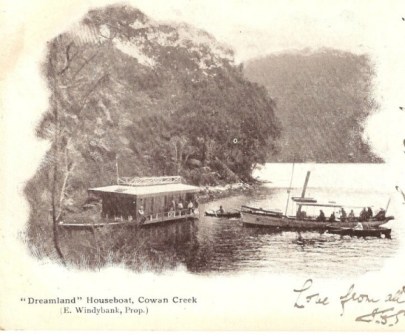 In the late 1890s Windybank built a boatshed at Waratah Bay, which became the centre of activity for holiday makers, day visitors and fishermen. The enterprising Windybank built and hired houseboats, at one stage there were 11. He owned two steamboats, Wildflower (1895) and Lady Zara (1903) before he owned a motor boat, Lady Alicia, which could carry 110 people, and a lifeboat from the SS Maitland (which had been wrecked off Broken Bay in 1898) with an added motor. Another purchase was a large paddle steamer, the “General Gordon”, which had been used by the Railway Department to transport passengers across the Hawkesbury River before the rail bridge was built. This boat was cut in half by Windybank and hired out as houseboats.
In the late 1890s Windybank built a boatshed at Waratah Bay, which became the centre of activity for holiday makers, day visitors and fishermen. The enterprising Windybank built and hired houseboats, at one stage there were 11. He owned two steamboats, Wildflower (1895) and Lady Zara (1903) before he owned a motor boat, Lady Alicia, which could carry 110 people, and a lifeboat from the SS Maitland (which had been wrecked off Broken Bay in 1898) with an added motor. Another purchase was a large paddle steamer, the “General Gordon”, which had been used by the Railway Department to transport passengers across the Hawkesbury River before the rail bridge was built. This boat was cut in half by Windybank and hired out as houseboats.
The Windybanks raised a family of seven at Waratah Bay, and the children went to school by horseback. Fresh water was obtained from a permanent spring, which still flows from the hillside on the Berowra side of the boatshed. There was a small orchard behind the house, an aviary and a fernery. Cows and horses were kept. A shop was run at the boatshed, and fresh daily supplies came by packhorse from Berowra, whilst larger items came in later years by monthly trading ship. Church services were held at the home, with Mrs Windybank playing the organ. Edward Clarke Windybank died in 1927 aged 78.
Addendum: Gordon Windybank, b. 1910, son of Edward & Alice Windybank, founded Windybank’s Bait & Tackle business on the Pacific Highway, Mt Colah in 1950 The Windybanks Interchange, Pacific Highway, is between Mt Ku-ring-gai and Berowra. Retrieved from http://www.khs.org.au/pdfs/news_aug09.pdf
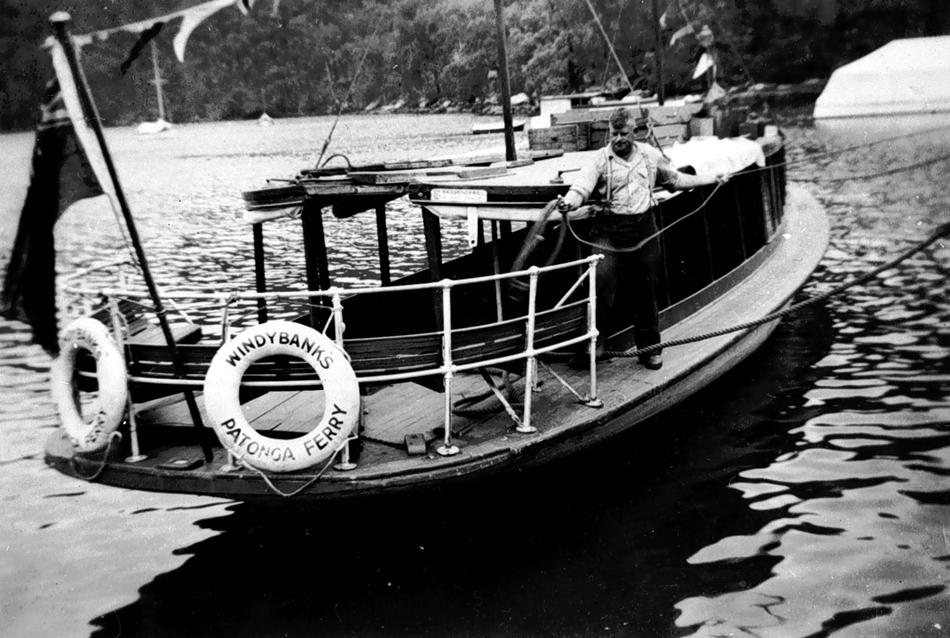
Ena II as Windybanks ferry, circa 1945, Courtesy Musueum of Victoria
The ferry shown is ENA which later became SWANHILDA on Pittwater in the Palm Beach to Basin, Mackerel Beach services. She was sold privately about 1970 and wandered around Port Jackson for a few years, looking progressively topheavy. NHI. GKA
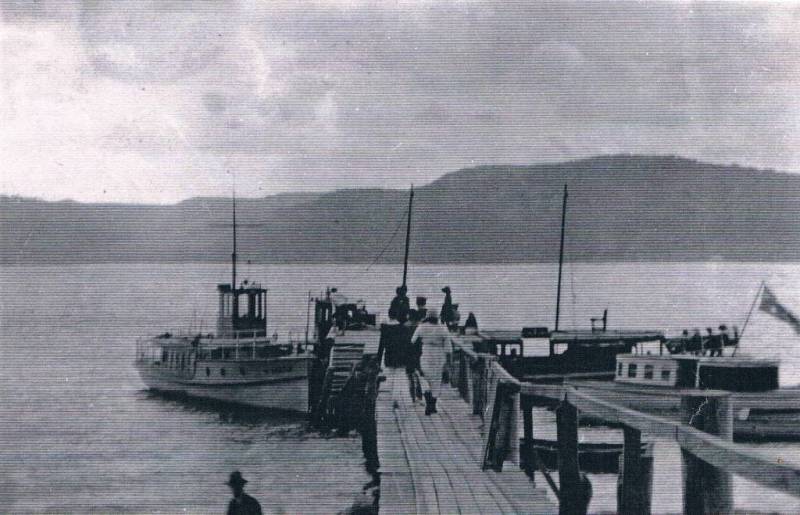
At Palm Beach Wharf late 1950's. image Courtesy Peter Verrills.
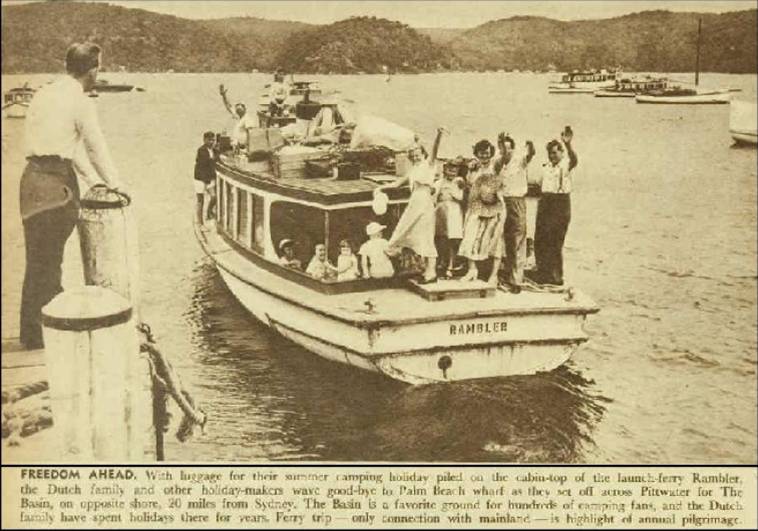
Across the blue water for a camping holiday. (1950, December 30). The Australian Women's Weekly (1933 - 1982), p. 12. Retrieved from http://nla.gov.au/nla.news-article47806278
Ena III
LAUNCH OF MR. T. A. DIBBS' NEW STEAM YACHT. Shortly after 9 o'clock on Saturday morning a handsome steam yacht, built for Mr. T. A. Dibbs, was launched from Mr. Ford's yard, Berry's Bay. As she left the ways she was christened "Ena" by Miss Dorothy Dibbs.
The launch was successful, the vessel taking the water almost without a move in her cradle. The new Ena is 100ft. overall by 16ft. beam, 8ft. 6in. deep, and will draw 7ft. 3in. On deck she will be fitted with elegant circular-top skylights of Moulmein teak, with embossed glass, forming also spacious seats on either side. There is a deckhouse amidships combining funnel casing, steering 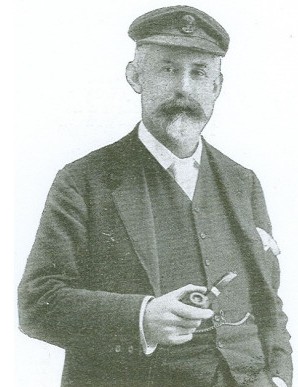 platform, stokehole entrance, galley, and engine-room, and so arranged that while giving ample room for their respective purposes, spacious promenade remains. Forward is a steam capstan of the latest design, and steering gear similar to that on Her. Majesty's yacht has been specially imported. Below are two saloon cabins. The forward or ladies' saloon, is 18ft. long by the full width of the ship, in which are six berths, wardrobes, whatnots, buffets, brackets, lockers, and cupboards arranged with a view to the most complete convenience. The after or gentlemen's cabin is 16ft. long, and has berth accommodation for no less than eight, together with sideboards, brackets, lockers, ice-chest, boot-racks, portmanteaux stowage accommodation, swing-table, glass-rack, and other minor fittings that go to make up a thoroughly appointed cabin.
platform, stokehole entrance, galley, and engine-room, and so arranged that while giving ample room for their respective purposes, spacious promenade remains. Forward is a steam capstan of the latest design, and steering gear similar to that on Her. Majesty's yacht has been specially imported. Below are two saloon cabins. The forward or ladies' saloon, is 18ft. long by the full width of the ship, in which are six berths, wardrobes, whatnots, buffets, brackets, lockers, and cupboards arranged with a view to the most complete convenience. The after or gentlemen's cabin is 16ft. long, and has berth accommodation for no less than eight, together with sideboards, brackets, lockers, ice-chest, boot-racks, portmanteaux stowage accommodation, swing-table, glass-rack, and other minor fittings that go to make up a thoroughly appointed cabin.
The vessel is schooner rigged with permanent awning over the main body, and white canvas port-able awnings cover the quarter-deck and bow. She carries two boats in davits arranged so that they maybe brought in on deck during bad weather at sea. The gangway is a special feature, giving the ease of access of a grand stairway. Steam at 120lb. pressure will be supplied by a large return tube marine type boiler to compound surface condensing engines having cylinders 12in. and 24in. diameter, and 16in. stroke, both with piston valves. The condenser is independent, and placed in the port wing ; the air feed, and bilge pumps are worked off the main crosshead, the circulating pump being an independent Worthington, and together with the universal donkey and ejector make up a complete outfit.
Electricity for lighting purposes will be generated by a Crompton direct coupled 8-horse power plant giving power and to spare to brilliantly illuminate the vessel fore and aft.
The new yacht, which is from designs by Mr. Walter Reeks (in picture), was built by Mr. W. M. Ford, jun., Berry's Bay, the machinery being by Messrs. Chap-man and Co. The inside fittings are of specially selected polished oak from the old warship Nelson, where they have been seasoning nearly 100 years, and were supplied by Messrs. Walker, Sons, and Bartholomew. The Ena will now receive her machinery. She is expected to be in full commission early in the new year. LAUNCH OF MR. T. A. DIBBS' NEW STEAM YACHT. (1900, December 10). The Sydney Morning Herald (NSW : 1842 - 1954), p. 5. Retrieved from http://nla.gov.au/nla.news-article14341852
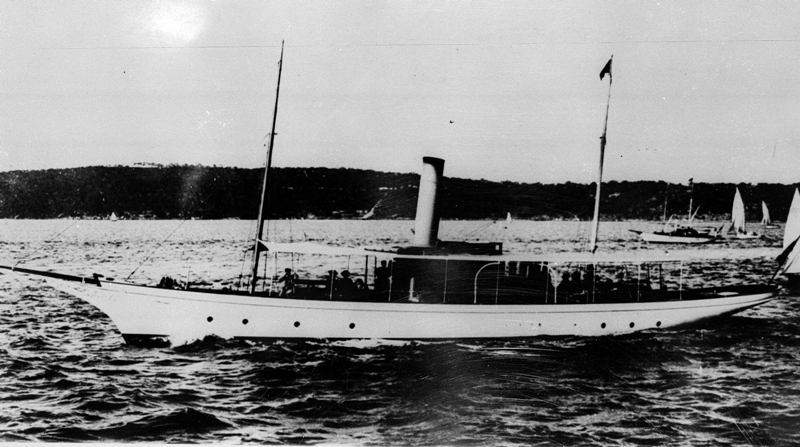
Steam Yacht Ena. Shortly after 9 a.m. on December 8, there was launched from Mr. Ford's yard, Berry's Bay, a handsome steam yacht, for Mr. T. A. Dibbs. As the vessel left the ways, she was christened Ena, by Miss Dorothy Dibbs. The launch went off without a hitch, the vessel taking the water al most without a move in her cradle. The Ena is 100ft overall, by 16ft beam, 8ft 61n deep, and she will draw 7ft 3in. On deck she will be fitted with elegant circular top skylights,- with embossed glass. There is a deckhouse amidships,- combining funnel casing, steering platform, stokehole-entrance, galley, and engine-roo: i. so arranged that while giving ample room for their respective purposes, ample promenade space remains. Forward is a steam capstan, of the very latest design, and the steering gear is similar to that fitted in her Majesty's yacht. The latter has been specially imported. Below are two magnificent saloon cabins; the forward, or ladies', saloon, is 18ft long by the full width of the ship, in which are six berths, with everything arranged with a view to convenience; the after, or gentlemen's, cabin, is 16ft long, and has berth accommodation for no fewer than eight persons. Lavatory arrangements are provided at both ends of the yacht. The Ena is schooner-rigged, with a permanent awning over the main body, and a white canvas portable awning covers the quarter-deck and bow. She carries two boats in davits arranged so that they may be brought in on deck during bad weather at sea. The gangway is a special feature, giving the ease of access of a grand stairway. Steam at 120lb pressure will be supplied by a large return tube marine type boiler, to compound surface condensing engines, having cyclinders 12in and 24in diameter, and 16in stroke, both with piston valves. The condenser is independent, and placed In the port wing, the air, feed, and bilge pumps being worked off the main cosshead; circulating pump being an independent Worthington, which together with the universal donkey and injector, make up a very complete outfit. Electricity for lighting purposes will be generated by a Crompton direct coupled 8-horse power plant, giving power to brilliantly illuminate the vessel fore and aft. The new yacht is from designs by Mr. Walter Reeks, and was built by Mr. W. M. Ford, Berry's Bay. The machinery is by Messrs. Chapman and Company. The inside fittings, which are all of specially selected polished oak, from the old warship Nelson (where they have been seasoning nearly-100 years), are by Messrs, W. Walker, Son, and Bartholomew. Every possible effort will be made to expedite completion, and the Ena' is expected to be in commission early in the new year. Steam Yacht Ena. (1900, December 22). Australian Town and Country Journal (NSW : 1870 - 1907), p. 51. Retrieved fromhttp://nla.gov.au/nla.news-article71387313
(G. George),Astreá (C.Marshall), Pleidès (Captain Evans), Ada (S.' Josephson), Valeria (G. J. Jackson).:Late in the afternoon the commodore Of the Royals (Mr: T. A. Dibbs), in the handsome new yacht Ena, steamed into Taylor Bay,' and dipped his Ensign to the Bronzewing.Cheers. from the latter vessel, called for by Mr. Hordern were enthusiastically given for the commodore of the Royals. Notes. (1901, November 2). Australian Town and Country Journal (NSW : 1870 - 1907), p. 52. Retrieved from http://nla.gov.au/nla.news-article71474128
BARRENJOEY Arrivals March 27 Ena (may be II or III), steam yacht at 8.30 am from Sydney (From the Board at the Telegraph Office.). (1902, March 28).The Sydney Morning Herald (NSW : 1842 - 1954), p. 4. Retrieved from http://nla.gov.au/nla.news-article14460540
ROYAL SYDNEY YACHT SQUADRON. The Royal Sydney Yacht Squadron will formally open their season to-day, when the yachts of the squadron will go through a series of evolutions. The fleet will assemble in Farm Cove at 2.30 p m , at which time the commodore (Mr T A Dibbs)will be present In his steam yacht Ena to receive them. The commodore will signal the various manoeuvres to be carried out from his yacht At the conclusion of the evolutions the craft will come to an anchor in some sheltered cove, when the crews will be invited to assemble on board the flagship. The club steamer Agenoria will leave Fort Macquarie at 2.30 p m for the convenience of members and their friends to watch the proceedings, and afterwards to convey them to the place of rendezvous ROYAL SYDNEY YACHT SQUADRON. (1902, October 18). The Sydney Morning Herald (NSW : 1842 - 1954), p. 10. Retrieved from http://nla.gov.au/nla.news-article14501199
ROYAL SYDNEY YACHT SQUADRON. OPENING OF THE SEASON. There was a very good attendance of yachts at the Royal Sydney Yacht Squadron's opening ceremony on Saturday, and the affair ITOB a success in everyway. The wind was perhaps on the light side, but for a function of tins kind racing wind is not desirable. The manouvres were well earned out, the various craft taking up their positions in very fine order. The yachts assembled in Farm Cove about half-past 2 o'clock, the handsome steam yacht Ena, belonging to the commodore (Mr. T. A. Dibbs), layout in the bay looking exceptionally graceful with her brass work shining like burnished gold. As each yacht approached her ensign was dipped, and acknowledged from the flagship. After the yachts had all saluted the signal, "Form squadron " was given, then came " Follow me inline in order of tonnage." This maneuver having been carried out the next order was " Rendezvous at Bradley's Head” then " Anchor as most convenient," which was promptly carried out, and the yachts bedecked with flags, after which the ever-welcome signal," Attend on board," was displayed. Amongst those who put off to the commodore's vessel were Dr. J.E. Elliott (vice-commodore), Messrs. T. H. Kelly(rear-commodore), J A. Minnett (hon. treasurer) of the Royal Sydney Yacht Squadron, W. A. Marks(vice-commodore), C. T. Brockhoff (rear-commodore) of the Prince Alfred Yacht Club, A. W. Crane (commodore Sydney Amateur Sailing Club), H. Smuts, Dr. M'Cormick, Dr. C. MacLaurin, A.R. Marks, R. Massey, W. Cope, S. M. Dempster, A.J. Souter, J. Thompson, W. H. Hallett (of the Clontarf, Ireland, Yacht Club), W. H. Gritton, R.B. Scott, and G. H. Leibius. After half on hour or so pleasantly spent on board partaking of the commodore's hospitality and generally looking over the ship the crews rejoined then vessels, and shaped a course for their moorings, all apparently well pleased with the outing. The following craft took part in the proceedings '-Ena (Mr. T. A. Dibbs), Electra(Mr, T. H. Kelly), Thelma (Dr. M'Cormick),Oithona (Mr. A. J. Soutar), Petrel (Mr. S. M. Dempster), Cooya (Mr. A. W. Crane), Oenone(Messrs. Marks and Heading), Cullulla (Sir. W.M. Marks), Fleetwing (Mr. C. T. BrockhofF), Bronzewing (Messrs. Manson and Young), Lahloo, Albicore (Dr. C. MacLaurin), Ada, SY, (Mr. Josephson), and Mr. Joseph Thompson's motor yacht. The club steamer followed the yachts during the manouvres, and afterwards anchored close to the flagship, the guests being ferried over to the commodore's yacht.
ON THE COMMODORE'S YACHT.
Commodore T. A. Dibb's beautiful steam yacht Ena put out from Lavender Bay wharf about 2 p.m. with a numerous company of guests. Amongst those on her were, in addition to the commodore, the following gentlemen; Captain T. B. Dibbs, Messrs. R. P. Hickson, James Grant, J. O. Fairfax, O. Dalrymple Hay, H. S. Dalrymple Hay, Alfred Milson (ex-commodore), Arthur Milson, Leslie Milson, Wilbam Hixson, Robert Massie, T. W-Bremner, Henty (Royal Victorian Yacht Club), Graham, Evans and Dudley, and Captain Christie, D S.O. The party was taken for a run to the head of Darling Harbour, thence to Farm Cove, where the yachts of the squadron saluted the commodore's flag, and finally to Athol Bight. There, after all sail had mustered, the officers, and in some cases the owners, of the various craft visited the Ena and were received by the commodore for half an hour or so the "harbour salts" talked yachting, exchanging reminiscences and talking of the future of Sydney's natural summer sport. Then Mr. W. M. Marks, vice-commodore of the P.A.Y.C., who represented that club in the absence in England of the commodore (Mr. S. Hordern) proposed the health of Mr. Dibbs. The toast was received with ringing cheers, supplemented by those from all on board the assembled yachts. The commodore, responding, referred to the pleasure be felt at having on board the commodore's yacht of the R S Y S, the vice-commodore of the rival club. The incident appeared to him to be is true indication of the community of interests winch exists among true sportsmen. The gathering broke up, and shortly-afterwards all craft were turned homewards. SAILING. (1902, October 20). The Sydney Morning Herald(NSW : 1842 - 1954), p. 4. Retrieved from http://nla.gov.au/nla.news-article14522345
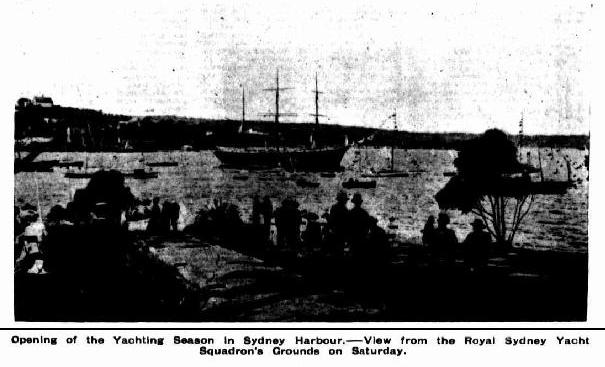 ROYAL Sydney Yacht Squadron. (See Illustration on page 25.) The opening of the season by the Royal Sydney Yacht Squadron, on Saturday, was a most successful function, and so far as yachting is concerned, may be described as unique. The scene at the club house, Kirribilli Point, North Sydney, was picturesque. At this delightful spot, Commodore T. A. Dibbs entertained several hundreds of ladles and gentlemen at a garden party. The club house is situated on a magnificent site, commanding a full view of the harbour-looking eastward. Throughout the afternoon, the guests wandered round the grounds, to the accompaniment of strains of music, supplied by tho Naval Brigade Band. The scene was enhanced by the presence of the yachts of the squadron, off the shore, moored snug, and dressed gaily with bunting, making altogether a very fine picture. The commodore's yacht Ena formed the central figure, and roundabout were craft of all descriptions-steam, oil, and sail. These included the Bronzewing (S. Hordern, P.A.Y.C.), Isis (SirJas. Fairfax), Electra (T. H. Kelly), Thelma(Dr. MacCormack), Olthona (A. J. Soutar), Isea(Dr. Nathan), Scotia (T. W. Bremner), Bronze-wing (J. W. Manson), Iduna (W. M. Cameron),Titania (J. J. Richardson), Fairlie (S. Fairland),Heather (N. Murray), Culwulla (W. M. Marks),Cooya (A. W. Crane), Wahina (Walter Reeks),Bul-Bul (C. M. Barker), Malua (E. Noyes), Tar-tan (Dr. Gordon-Cralg). By arrangement with the Squadron, the Sydney Dingey Club opened its season, and made the finishing point at a boat moored almost immediately off Kirribilli. The idea was a good one, and added further interest to the whole show. To mark the opening, the committee presented two beautiful bouquets to Mesdames Flaherty and J. J. Richardson. Summed up briefly, the garden party was one of the successes of the present season. Mr, Sid. T. Wilson, secretary of the R.S.Y.S., was greatly in evidence throughout the day, and did much in assisting his commodore to make the guests as happy and as much at home as was possible. Royal Sydney Yacht Squadron. (1903, October 21). Australian Town and Country Journal (NSW : 1870 - 1907), p. 25. Retrieved from http://nla.gov.au/nla.news-article71487087
ROYAL Sydney Yacht Squadron. (See Illustration on page 25.) The opening of the season by the Royal Sydney Yacht Squadron, on Saturday, was a most successful function, and so far as yachting is concerned, may be described as unique. The scene at the club house, Kirribilli Point, North Sydney, was picturesque. At this delightful spot, Commodore T. A. Dibbs entertained several hundreds of ladles and gentlemen at a garden party. The club house is situated on a magnificent site, commanding a full view of the harbour-looking eastward. Throughout the afternoon, the guests wandered round the grounds, to the accompaniment of strains of music, supplied by tho Naval Brigade Band. The scene was enhanced by the presence of the yachts of the squadron, off the shore, moored snug, and dressed gaily with bunting, making altogether a very fine picture. The commodore's yacht Ena formed the central figure, and roundabout were craft of all descriptions-steam, oil, and sail. These included the Bronzewing (S. Hordern, P.A.Y.C.), Isis (SirJas. Fairfax), Electra (T. H. Kelly), Thelma(Dr. MacCormack), Olthona (A. J. Soutar), Isea(Dr. Nathan), Scotia (T. W. Bremner), Bronze-wing (J. W. Manson), Iduna (W. M. Cameron),Titania (J. J. Richardson), Fairlie (S. Fairland),Heather (N. Murray), Culwulla (W. M. Marks),Cooya (A. W. Crane), Wahina (Walter Reeks),Bul-Bul (C. M. Barker), Malua (E. Noyes), Tar-tan (Dr. Gordon-Cralg). By arrangement with the Squadron, the Sydney Dingey Club opened its season, and made the finishing point at a boat moored almost immediately off Kirribilli. The idea was a good one, and added further interest to the whole show. To mark the opening, the committee presented two beautiful bouquets to Mesdames Flaherty and J. J. Richardson. Summed up briefly, the garden party was one of the successes of the present season. Mr, Sid. T. Wilson, secretary of the R.S.Y.S., was greatly in evidence throughout the day, and did much in assisting his commodore to make the guests as happy and as much at home as was possible. Royal Sydney Yacht Squadron. (1903, October 21). Australian Town and Country Journal (NSW : 1870 - 1907), p. 25. Retrieved from http://nla.gov.au/nla.news-article71487087
Amongst other boats which carry the name of W. M. Ford on their rudder-heads, and which have made themselves famous, may be mentioned Sirocco, Sao, Electra, Isea, Jess, Bethune, Maysie, and last, but by no means least, White Wings and Fleetwing, built for Mr. Samuel Hordern. The Ena, the graceful steam yacht of Mr. TA. Dibbs, is also one of the productions of Mr. Ford's yard. OUR INDUSTRIES. (1905, April 26). The Sydney Morning Herald (NSW : 1842 - 1954), p. 7. Retrieved from http://nla.gov.au/nla.news-article28240882
This sleeker Ena III was sold to the government for a nominal fee of one thousand pounds, far less then she cost, and headed north during WWI to New Guinea:
The steam yacht Ena, owned by Mr T. A. Dibbs, of Sydney, has been sold to the Commonwealth Government, and has just been handed over. The vessel, it is understood, will be sent to Thursday Island, and used as a despatch boat round the islands and the coastline in the vicinity. Events And Rumors. (1916, November 21). Camperdown Chronicle (Vic. : 1877 - 1954), p. 3. Retrieved from http://nla.gov.au/nla.news-article65014072
 Image: SYDNEY, NSW. ELEVATED PORT QUARTER VIEW OF THE BOYS' TRAINING SHIP HMAS TINGIRA (EX SOBRAON). IN THE FOREGROUND IS THE YACHT ENA, WHICH WAS COMMISSIONED INTO THE RAN AS THE PATROL BOAT HMAS SLEUTH (I) DURING WORLD WAR 1. (NAVAL HISTORICAL COLLECTION, PRESENTED BY MR J. MILLAR). Image 301557
Image: SYDNEY, NSW. ELEVATED PORT QUARTER VIEW OF THE BOYS' TRAINING SHIP HMAS TINGIRA (EX SOBRAON). IN THE FOREGROUND IS THE YACHT ENA, WHICH WAS COMMISSIONED INTO THE RAN AS THE PATROL BOAT HMAS SLEUTH (I) DURING WORLD WAR 1. (NAVAL HISTORICAL COLLECTION, PRESENTED BY MR J. MILLAR). Image 301557
She remained part of Mr Dibb's collection of vessels named 'Ena' until his passing on March 18th, 1923 and was then sold to William Longworth and went north for a few years until this gentleman's passing caused her to be deposed of by those looking after his estate. It was here that she commenced her career as a ferry:
YACHT ENA. SOLD FOR TRADING. The steam yacht Ena, formerly the property of the late Sir Thomas A. Dibbs, has been sold to a buyer from Newcastle. The vessel was used by her former owner entirely as a pleasure craft, but the new owner intends to place her in passenger trade on Lake Macquarie. The Ena is expected to leave for Newcastle today. Built at Sydney In 1901, the Ena is a wooden vessel 88 feet in length, with beam of 16½feet, and depth of 8.1 feet. For many years she has been a familiar figure on the harbour. YACHT ENA. (1924, April 24). The Sydney Morning Herald(NSW : 1842 - 1954), p. 10. Retrieved from http://nla.gov.au/nla.news-article16153422
Dangerous Voyage. DISABLED MOTOR LAUNCH. ADRIFT FOR ELEVEN HOURS. Captain R. E. Evans, of Melbourne, and Eric Rutley, of Wyee, drifted for eleven hours on Sunday for miles off the coast when the motor launch, Ena, became disabled in a heavy swell. The launch, which is of 44 tons, was formerly owned by Sir Thomas Dibbs. The party left Lake Macquarie on Friday night for Sydney; but, after about three hours, the awning collapsed, smashing the steering gear. The swell became heavier, and the small craft was bashed about on the waves.' A piano was thrown overboard when the vessel lurched dangerously. The funnel was carried away, and, though the men eventually managed to repair the steering gear, the engines were seriously affected. An attempt was made to keep on the track of shipping by making a small sail, and, shortly before 10 o'clock on(Saturday morning, they were sighted by the steamer Iron Warrior, and towed to Newcastle. Dangerous Voyage. (1927, March 8). The Muswellbrook Chronicle (NSW : 1898 - 1955), p. 1. Retrieved from http://nla.gov.au/nla.news-article107606301
ELEVEN HOURS ADRIFT Motor Launch's Plight NEWCASTLE (N.S.W.), Sunday. Captain R. E. Evans, of Melbourne, and Eric Rutley, of Wyee, drifted eleven hours yesterday several miles off the coast, when the motor launch Ena became disabled in a heavy swell. The piano was thrown overboard when the Vessel lurched perilously, and the dinghy broke away. The engines and steering gear were rendered useless. The vessel was sighted by the steamer Iron Warrior and towed to Newcastle. ELEVEN HOURS ADRIFT. (1927, March 7). Examiner(Launceston, Tas. : 1900 - 1954), p. 5 Edition: DAILY. Retrieved from http://nla.gov.au/nla.news-article51410530
OLD FERRIES PASS. "BRONZEWING" AND "CYGNET." Well known to old residents of the upper Parramatta, two old ferries, the Bronzewing and the Cygnet, which were placed out of commission by Sydney Ferries, Ltd., some time ago, are to be offered at auction. Fraser, Uther, and Co., Ltd., will conduct the sale at their rooms in Underwood-street on Tuesday. The ferries are the last of the "bird" class, some of the first units of the company’s fleet. Two other vessels of the same class, the Pheasant and the Gannet, have already been disposed of. The lighter Lorna Doone and the steam yacht Ena will be put under the hammer on the same day. OLD FERRIES PASS. (1930, May 17). The Sydney Morning Herald (NSW : 1842 - 1954), p. 19. Retrieved from http://nla.gov.au/nla.news-article16678633
FERRY BOATS NOT SOLD ALTHOUGH bidding was at times ' brisk among the large crowd at Fraser, Uther and Company's rooms to day, none of three well-known steamer ferries offered at public auction found on behalf of Sydney Ferries, Ltd.. the steamers Bronzewing, Lorna Doone and Cygnet were submitted for sale. The trio has rendered years or valuable service In the Parramatta River-Sydney run. The best offer for the Bronzewlng was£360, but this was declined and the vessel was passed in. For the Lorna Doone, no better bid than £25 could be obtained, and only f.55 was offered for the Cygnet. They also were passed in. The steam yacht, Ena, was also offered for sale, but after bidding had stopped at £775 the yacht was passed in. FERRY BOATS NOT SOLD. (1930, May 20). Evening News (Sydney, NSW : 1869 - 1931), p. 8. Retrieved from http://nla.gov.au/nla.news-article117479450
Offered on behalf of the estate of the late Mr.W. Longworth, the steam yacht Ena realised £775, subject to the consent of the executors. SALE OF OLD FERRIES. (1930, May 21). The Sydney Morning Herald (NSW : 1842 - 1954), p. 18. Retrieved from http://nla.gov.au/nla.news-article16674087
A little on William Longworth, another of our early entrepreneurs:
PHILANTHROPIST 'S DEATH. MEMORIES OF COBAR. Mr. William Longworth, whose death occurred at his Port Stephens home at Karuah yesterday, was a member of the original Cobar Syndicate, with his brother, the late Mr. Thomas Longworth. Sir Albert Gould, Dr Richard Read, and others. The story of the famous Cobar mine constitutes one of the most fascinating chapters in the mining his-tory of Australia. Mr. Longworth came to Australia from Eng-land in early childhood. The young colonist made himself an expert In all matters that related to coal, as well as metalliferous mining. It was in the nineties that Mr. Longworth and his associates obtained a lease at Cobar. Eventually the shares in the mine were boughtby the new company, and the mine became their own. By the introduction of modern machinery and methods, including the crucible water jacket furnace, and under the guidance of William and Thomas Longworth as managers, the mine became a very profitable concern. The Cobar Syndicate subsequently found that there was a fair proportion of gold in the copper that was being exported to Europe (principally to Germany), and re-solved to secure it themselves. This was carried out with considerable success at Lithgow, under the direction of the late Mr. Longworth. Eventually, Cobar Syndicate disposed of its rich holding to an English company, with a capital of £1,500,000. This concern, how-ever, did not obtain the success of the former Australian owners, but met with labour and other difficulties, and eventually went into liquidation. Though Cobar was the principal source of the wealth of the Longworth brothers, they were successful In other under-takings, including several coal-bearing properties. With others, they were also instrumental in establishing the Australian Woollen Mills. Mr. W. Longworth's pastoral activities were also successful. Only recently Mr. Longworth built, equipped, and endowed a hospital for children at Waratah, at a cost of £15,000 He distributed£12,000 in one sum among hospitals and other institutions. It is estimated that his benefactions in this manner during the last few years totalled £30.000. One of his last gifts was the purchase and endowment of a building in Newcastle, known as the Longworth Institute, at a cost of £8000. He also made gifts to many of his old friends in humble circumstances. Mr. Longworth was married twice. His first wife died many years ago. He is survived by Mrs. Longworth, a step-son (Mr.James New, of Sydney), and a step-daughter(Mrs. Hazel Bennett, of Raymond Terrace), and many nieces and nephews. His sisters, all of whom reside in Sydney, include - Mrs.Kelly, Mrs. Hart, Mrs. Burns, Mrs. Skillen, Mrs. W. W. Robinson, and Miss Alice Longworth. The funeral will take place to-morrow, at the Church of England Cemetery, Whittingham, near Singleton. MR. W. LONGWORTH. (1928, December 6). The Sydney Morning Herald (NSW : 1842 - 1954), p. 12. Retrieved from http://nla.gov.au/nla.news-article16514854
YACHT ENA SOLD. WAR PATROL VESSEL. The sale of the 65-ton steam yacht Ena to a syndicate is announced. The vessel has been laid up at Sydney for some time, but is well-known for her services as an armed patrol steamer off the coast of New Guinea and round Thursday Island during the war. Built by W. M. Ford, Junior, of Berry's Bay, in 1901, for the late Sir Thomas Dibbs, she was sold to the Australian Navy on the outbreak of war, and was fitted with a small gun. She was able to do valuable work by reason of her small draught. After the armistice she was purchased by the late William Longworth, of Port Stephens, whose executors have now disposed of her. The new owners have not yet announced their plans. YACHT ENA SOLD. (1931, April 7). The Sydney Morning Herald(NSW : 1842 - 1954), p. 8. Retrieved from http://nla.gov.au/nla.news-article16767416
FILMING THE FAR NORTH. Scientific Party's Cruise. According to statements in Eastern States papers, an expedition to the far north of Australia, for the combined purposes of conducting and investigation and making a sound film, will shortly leave Sydney under the leadership of Mr. J. L: Osborne, a photographer and sound technician. The steam yacht Ena will be used by the party, which will include ten scientists. The yacht will be commanded by Captain Kettle, formerly of the Pacific mission steamer John Williams, and among the party will be Mr. H. Slocombe, an authority on the life of the dugong, and Mr.J. Parker, who has spent more than 20 years in the Gulf country. It is stated that, in view of the recent revival of reports that two women survivors of the wrecked coastal steamer Douglas Mawson have been held captive by the blacks of Arnhem Land since 1924,Mr. Osborne's party will co-operate with the Roper River' police in a further attempt to find some traces of the missing women. Protracted investigations were made by a Government expedition at the time, but without result. In the following year Sir Herbert Wilkins. the explorer, made a further search, and reported that there was no evidence to support the suggestion that the women had not perished with all the other persons on the Douglas Mawson. However, rumours of the captivity of the women persist. To make certain that no shred of evidence is overlooked, instructions have been issued tothe Roper River po]ice to make contact with the Arnhem tribe and make further inquiries. Mr. Osborne's expedition will make inquiries in conjunction with, and. independently of, the Roper River police. The first sound 'shots' after leaving Sydney will be made at the Great Barrier Reef. Cruising there for three months the party will study the swarms of birds which make nests on the atolls and islets. The turtle will also be studied, and theparty will ' engage in hunting sharks and size-fish. In the late autumn they will proceed through Torres Straifs to the Guifof Carpentaria, shooting crocodile in the river estuaries, and making inquiries regarding the allegedly missing women. A buffalo hunt in Arnhem Land is also planned, the party proceeding thence to Darwin. The talkie scenes will include pictures of pearl-fishing at Broome. It is hoped to obtain 10.000 feet of film. Finally the yacht will return to Sydney, via Fremantle and Melbourne. FILMING THE FAR NORTH. (1932, January 29). The West Australian (Perth, WA : 1879 - 1954), p. 13. Retrieved from http://nla.gov.au/nla.news-article32390468
STEAM YACHT ENA. CAPTAIN DRISCOLL'S PURCHASE. ALTERATIONS AT HOBART. Captain W. Driscoll's steam yacht Ena is undergoing alterations on the slip at Battery Point, the vessel having been lying off Sandy Bay of late, and much interest has centred in her by reason of her graceful and speedy lines. The vessel, which has a clipper bow and counter stern, is of 44 tons register, and is 100ft. long, with a beam of 16ft. 5in. She was built in the slipyard of Mr. W. M. Ford at Barry Island, in 1902. The hull is constructed of spotted gum, and is plated with Muntz's metal to the waterline, with kauri sides. The plating is for protection against marine insects in tropical waters. Fitted with a 25 h.p., Chapman engine, with single screw, her speed is estimated about 9 knots.
The history of the Ena is interesting. Built originally as a pleasure yacht for Mr. Anthony Hordern, of Sydney, she was sold to Sir John Dibbs, who used her for pleasure and fishing trips. During the war she was sold to the Commonwealth Government for naval use and was fitted with a gun, and did service as a patrol boat at Thursday Island under the name of Sleuth. At the conclusion of the war she was bought by Mr. W. Langworth, and stationed at Port Stevens. Her present owner Captain Driscoll, who is well known around Hobart, bought the vessel in Sydney and his intention is to have her fitted for carrying apples and to use her in the trade to Cygnet. Later the vessel will be refitted for the passenger service and will be available for charter and pleasure trips. STEAM YACHT ENA. (1933, March 3). The Mercury (Hobart, Tas. : 1860 - 1954), p. 14. Retrieved from http://nla.gov.au/nla.news-article24706108
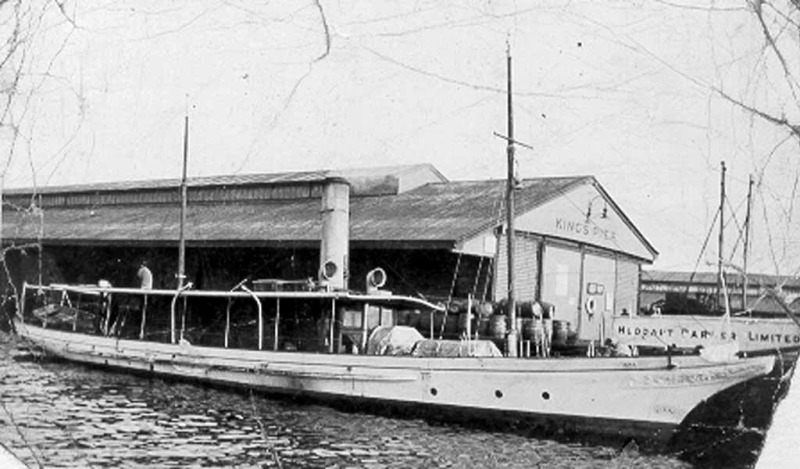
Ena II at King's Wharf, Tasmania, 1933, courtesy State librray of Tasmania.
CHANNEL TRADE. Alleged Breach of Covenant. Injunction to Restrain Sought in the Supreme Court at Hobart yesterday, before the Chief Justice (Sir Herbert Nicholls), the hearing was concluded of the case In which the Huon Co-operative Transport Pty. Ltd. sued Walter Driscoll, master mariner, of Hobart, for £249 damages for alleged breach of covenant, and sought an injunction to restrain Driscoll from further indulging in competition with the plaintiff company In the Huon and Channel shipping trade. Mr. C. S. Page (Page, Hodgman, Seager and Doyle) appeared for the Huon Co-operative Transport Pty. Ltd., and Mr. H. S. Baker (Finlay, Watchorn, Baker and Turner) for defendant The evidence for the plaintiff was heard on Tuesday. Walter Driscoll stated that he was 54 years of age and had been engaged in the river trade all his life. When the Bass Co. sold out to the Huon Co- operative Transport Pty. Ltd. it had been in existence about 12 years. Witness had 700 of the 4,000 shares in the Bass Co., and was master of the steamer Ena. The ports to which he had been trading included Cygnet ports, North Bruny, Gordon, Tinderbox, and the northern side of the Huon River. In 1933, subsequent to the sale, he visited Gardner's Bay, Crooked Tree, Cygnet, and Garden Island Creek in the steamer Ena between March 8 and March 30. In March, 1934, he visited Lunawanna, Alonnah, Barnes Bay, Simpson's Bay, Kettering, Southport, and Esperance. There was very little trade offering at Barnes Bay, which was not a regular port of call for the Channel steamers. He was part-owner of the Ena, a small ship which he acquired in Sydney, and used in the river trade after the sale of the Bass Co.'s assets. When the Bass Co. was wound up witness received cash instead of shares in James Rowe and Sons Pty. Ltd.
To Mr. Page: Before entering into the river trade In the Bass he had made six trips to Melbourne in a ketch. If he went back into the river trade he would be a serious competitor with the Huon Co-operative Transport Pty. Ltd. The Ena was not run this year on a share basis, and the crew had been paid award wages. When the Bass Co. sold out witness signed the agreement undertaking not to compete with the Huon Co-operative Transport Pty. Ltd. He used the money which he derived from his share of the sale of the assets to purchase the Ena.
Charles Leigh Johnston, formerly secretary to the Bass Steamship Co., said the company's average receipts for a year had been £6,000. The bulk of the trade was secured from ports in the Cygnet and Garden Island Creek district. After hearing addresses by counsel His Honor reserved his decision. CHANNEL TRADE. (1934, September 20). The Mercury (Hobart, Tas. : 1860 - 1954), p. 3. Retrieved fromhttp://nla.gov.au/nla.news-article24965652
The Depression was at its height in Australia during these years and although Mr Driscoll eventually won this court battle he was happy to accept an offer when one came along:
TRAINING SHIP Ena To Be Recommissioned. The one time ocean-going pleasure yacht Ena, which has been idle on the Hobart waterfront for several years, will soon be commissioned as a training ship and go to sea under a' crew ot boys. Hobart interests have almost completed-arrangements with Capt. W. Driscoll, owner of the vessel, for Its purchase. The ship will lake a permanent, crew ot 20, and 20 boys also will volunteer for week-end training cruises. The boys will be chosen from those less privileged, and shipping companies and the Naval Department have promised to co-operate as far as possible in the absorption of the trainees. Old mariners and engineers have been engaged as instructors, and the venture will be under a Board of Control. SHIPPING INFORMATION. (1937, January 20). The Mercury (Hobart, Tas. : 1860 - 1954), p. 2. Retrieved from http://nla.gov.au/nla.news-article30134499
MARINE SCHOOL Instruction Ship Nearly Ready For Use. The work of recommissioning the steamer Ena, which is to be used as a training ship, is proceeding at Hobart. It is expected that the ship will soon be ready for the water. The hull will be thoroughly dried out and repainted. Efforts are being made to have the ship in full commission, and the boys in uniform, by November. It is hoped that the ship will attend the first regatta, to be held at Woodbridge. The project will be known as the Marine School of Instruction, and Its object is to provide schooling for boys who are not getting a good chance in life. The Police Social Club has decided to assist to raise funds for uniforms, slipping, painting, etc. MARINE SCHOOL. (1937, July 24). The Mercury (Hobart, Tas. : 1860 - 1954), p. 9. Retrieved fromhttp://nla.gov.au/nla.news-article25415286
Training Ship The former ocean going pleasure steamer, Ena (125 tons) which has been swinging idly at her moorings in the Derwent for two years, has been made into a training ship for youths between the ages of 14 and 161, years. They will be taught seamanship, engineering, sailmaking, and navigation under expert instructors and fitted for posts in the navy and mercantile marine. Boys from the Hobart High School and Technical College, two engineers, an ex yeoman of signals, Mr. George A. Collis, and others have effected re pairs and renovations and the Ena will go on to a slip soon to have her hull sheathed with copper, and to be overhauled and surveyed. It is proposed that the vessel at all times will be in readiness to answer emer gency calls on the Tasmanian coast. She will visit Sydney in March next for the Centenary Regatta there. The scheme was evolved by Mr. Collis and inspired by Commander C. B. Fry during his visit to Tasmania seven months ago with the English cricketers. The co-operation of the Federal Government has been obtained and the boys will be provided with smart uniforms. CURRENT TOPICS. (1937, August 30). Examiner (Launceston, Tas. : 1900 - 1954), p. 6 Edition: LATE NEWS EDITION and DAILY. Retrieved from http://nla.gov.au/nla.news-article52157555
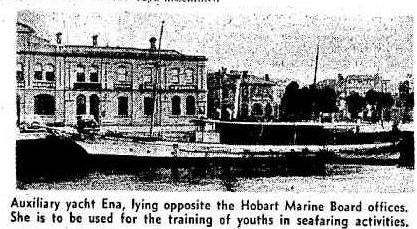 Youth Training Experiment Long Week-End On Recommissioned YachtDOWN the River Derwent last Saturday morning sailed a craft not seen in commission for long years, and onboard it a crew as remarkable as the vessel. She was the S.S. Ena, formerly belonging to Sir Anthony Hordern, a yacht which, in its day, was regarded as one of the most luxurious and beautiful vessels in Australian waters. The crew consisted of boys from several schools who had worked to recondition the Ena, and with them went Mr. George Collis, who skippered her, Mr. W. Downie, magistrate of the Children's Court, and Mr. G. Stockdale, Welfare Officer of the Education Department. The purpose was a long week-end to give the boys a chance to see the result of their handiwork and, furthermore, to justify a scheme which the Ena represents-namely, the training of uncared-for youths to become sailors and to teach them the elements of proper living in healthy surroundings.
Youth Training Experiment Long Week-End On Recommissioned YachtDOWN the River Derwent last Saturday morning sailed a craft not seen in commission for long years, and onboard it a crew as remarkable as the vessel. She was the S.S. Ena, formerly belonging to Sir Anthony Hordern, a yacht which, in its day, was regarded as one of the most luxurious and beautiful vessels in Australian waters. The crew consisted of boys from several schools who had worked to recondition the Ena, and with them went Mr. George Collis, who skippered her, Mr. W. Downie, magistrate of the Children's Court, and Mr. G. Stockdale, Welfare Officer of the Education Department. The purpose was a long week-end to give the boys a chance to see the result of their handiwork and, furthermore, to justify a scheme which the Ena represents-namely, the training of uncared-for youths to become sailors and to teach them the elements of proper living in healthy surroundings.
The brief: the aim is to provide a training ship for the-youth of Hobart who have no place elsewhere, and so to train them that they may become efficient sailors, and possibly take their places in the navy or other calling. The movement originated out of remarks made by Cmdr. C. B.-Fry, the well known ex-international cricketer, who, during a visit to Hobart, suggested that good work could be done by commissioning the Ena and trying to Ira in boys for the sen. The suggestion was seized on eagerly by several citizens, who first set about forming a board of control. Enlisting the sympathy of many Interested persons, they formed the board, which consists of Mr. C. Seager, Director of Social Services; Superintendent W. Oakes, of the Metropolitan Police; Mr. G. Stockdale, and Mr. IV. Clark.
When the Ena was examined it was found in a parlous condition. Her engines were rusted, and apparently useless, brasswork was foul, and covered with an accumulation of dirt, cabins were filthy, and damaged here and there, and the whole condition of the craft bore warrant to her decay and exposure. It was to tackle this state of affairs that the first move was made, and to do It the aid was enlisted of boys from the Hobart Technical College, the State High School, and tradesmen's apprentices
The boat became a scene of activity lasting several months, and though there were not wanting those who shook their heads over the possibility of turning her out as a seagoing vessel of use, the result is such as to astonish those who visit her.
The workers set about their job with a' will. The engines were completely dismantled, every part being carefully cleaned, and polished where necessary. A thorough examination of everything was made, and finally, when reassembled, the engines were found to be not merely sound, but almost perfect. Last of all she was placed on the slip and the copper sheathing overhauled. In addition, the decks were stoned and cleaned, cabins furbished, bunks made up, and generally she was recommissioned for service.
IT remained then to put her to the test, and the long week-end was chosen for the purpose. But a serious difficulty cropped up that threatened the success of the whole scheme, sphere was no money to provide fuel for the boiler, to victual her, or to do any of the hundred and one necessary things that needed doing. Those who had helped liberally so far had felt the strain during the long period of overhaul and were unable to continuo to bear the brunt. But help came. The scheme had been put before the Lord Mayor(Mr. J. .1. Wignall), who was so interested In it and so satisfied that It was worth a trial that be decided to make available the amount needed to cover the first trial. Action was resumed and the Welfare Officer was asked to select a number of lads from various districts and invite them to be the guests of their commissioning crew for the week-end. Everything moved apace, the services of a trained cook were engaged, food Was laid in, fuel obtained, and on Saturday, with a full head of steam, the Ena put out from Hobart, manned by the boys who had turned her from a broken down apparent piece of wreckage into a smart-looking craft with much of her old jauntiness. With engines like clock-work she nosed her way down the river for Barnes Bay, and the dream of the sponsors came true.
Sunday evening saw her In Simmond Bay and after ten the boys assembled
Auxiliary yacht Ena, lying opposite the Hobart Marine Board offices. She is to be used for the training of youths in seafaring activities.
In the forcastle, where they listened to plain man-to-man talks by Mr. Downie and Mr. Stockdale. Mr. Downie told them that he was sure there were plenty of people In the community who would help them to make good if they showed their willingness to do so and played the game. On Monday morning the Ena left Bruny and made her way to Woodbridge Regatta, finally setting back to port about 6 p.m.
This was the trial trip in which the boys from the various schools who had worked on the vessel were able to seethe results of their knowledge and handiwork and at the same time act as hosts to others less fortunate than themselves. The ultimate purpose of the scheme is to obtain support from citizens of Hobart to enable the Ena to be kep tin commission, and, with its trained crew of boys in uniform, attend the Centenary Regatta, thus making clear to all that boys, given a fair chance of training, with proper conditions of living, can and will justify themselves by growing into good and useful members of the community. The sponsors of the scheme are convinced that many of the youth who find themselves in trouble are more the victims of circumstance than morally deranged, and It Is this belief that has Inspired them to continue In spite of difficulties. It was felt that a helping hand stretched out when needed might rescue many from later evils, and that belief has urged them along the course they have pursued. Supporting such belief that training Is the chief requirement, Mr. Stockdale said he was satisfied that boys who had been train-ed In technical schools were ready to be absorbed Into Industry, and he heartily congratulated them -on their fine work In reconditioning the Ena.
The work has gone so far. Citizens have come forward and given help, while the labour done by the workers from the various schools Is not only very great, but remarkably sound. The fate of the scheme depends on what the citizens of Hobart think of this plan to train uncared-for youth so as to make them Into good living members of the community mid equip them with a means of earning a living. For these things funds will be needed, and those who have devoted their time, energy, and money to bringing their plan to its present stage hope that their efforts will he endorsed by the support of others. Picture: Youth Training Experiment. (1937, November 6). The Mercury(Hobart, Tas. : 1860 - 1954), p. 12. Retrieved from http://nla.gov.au/nla.news-article29190219
GRACEFUL LINES Picture (poor quality) The Ena still reveals the graceful lines of her past. -Barnett. Former Luxury Steam Yacht, Naval Patrol, Now in Scallop Industry Among the most beautiful pleasure craft in Australian waters years ago, the ocean going steam yacht Ena is now one of the ships engaged in the Hobart scallop trade. Her life has been full of ups and downs since 1900 and she is far from being permanently down. WITH an overall length of 106ft.,beam of 20ft., and 125 tons displacement, Ena was built at North Sydney in 1900 for Mr. Anthony Hordern (this is not correct; the Bronzewing was a shorter lighter vessel: see below), who used her as a luxury ocean-going pleasure yacht. As such she was well known throughout Australia for her graceful lines and luxurious fittings. When World War I. came Ena became H.M.A.S. Sleuth, and her Brasswork shone more than ever as smart blue jackets manned a small caliber gun mounted on her bow. Sleuth did coastal patrol and quarantine work during the war. When it ended she reverted to her former role of pleasure yacht, but without much of her former glamour. No longer in the first bloom of youth she began to get her first experience of neglect. Captain W. Driscoll bought her in 1933, and sailed the yacht to Tasmania with the idea of trading to Bruny Island. It was not long before she was withdrawn from this service, and for the first time in her life Ena became really idle. Her beauty caught the eye of Commander C. B. Fry, the former international cricketer, when he visited the state before the war, and he suggested the useful work that Ena could do if she were fitted up as a training ship. The idea was taken up, and once again Ena shone and glistened proudly. The yacht made several expeditions under the new scheme of training boys from Ashley Boys' Home, Deloraine, as sailors, but the plan lapsed after a while, and once again Ena was left in neglect. Now in her latest stage of life Ena has become a commercial proposition for getting scallops, but passers by on the wharves always stop to take a second look at her with the deference due to a graceful ship with a past and, perhaps, a future. GRACEFUL LINES. (1946, May 10). Examiner (Launceston, Tas. : 1900 - 1954), p. 5. from http://nla.gov.au/nla.news-article92691827
Ferry historian Graeme Andrews in his article for Afloat magazine, The Long, long, long story of the Ena/Slueth/Aurore/Ena states the Ena was fitted with a diesel engine post 1946 and went north to do shark fishing work in Queensland until at least 1964. By 1981, as the Aurore she was back in Tassie, hit a submerged object in the Derwent and sank. In 1982 she was raised, bought by a syndicate in Sydney and returned to our harbour for extensive repairs and now works again. See HERE
References
1. G. J. Abbott, 'Dibbs, Sir Thomas Allwright (1832–1923)', Australian Dictionary of Biography, National Centre of Biography, Australian National University, http://adb.anu.edu.au/biography/dibbs-sir-thomas-allwright-308/text518
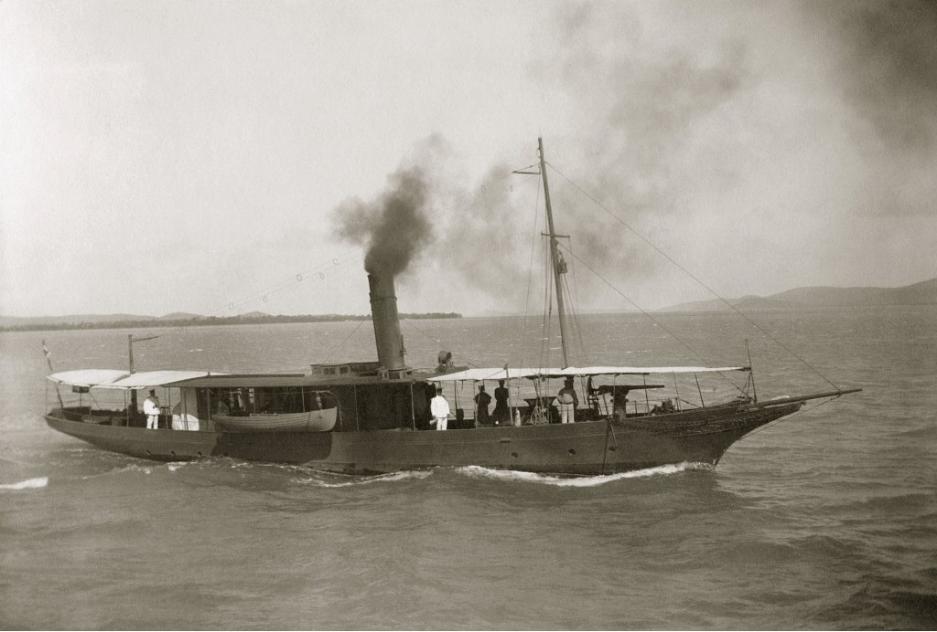
HMAS Sleuth, an armed yacht of the Royal Australian Navy, during the last years of World War I. This image was taken off the Australian Queensland coast on 18 June 1917.
Port Jackson Pleasure Fleets
Written for the Evening News by Lanyard
NO. -7.
Loud and sudden there was heard,
All around them and below,
The sound of hammers, blow on blow,
Knocking away the shores and spurs.
And see! she stirs!
She starts,--she moves,--she seems to feel
The thrill of life along her keel,
And, spurning with her foot the ground,
With one exulting, joyous bound,
She leaps into the ocean's arms!
The Building of the Ship, from The Seaside and the Fireside by Henry Wadsworth Longfellow, (1807-1882).
Who was it said when a ship, is launched a child is born to the ocean? As a rule, there is not much poetry about the launching of one of our yachts; we follow British custom at such a function' just as, regardless of the difference in condition's here, we feast on roast beef and plum pudding at Christmas. Still, our ceremony is in advance of the old Fijian one- of launching a war-canoe over the prostrate bodies of friends and relatives, if the-supply of enemies did not meet the demand;
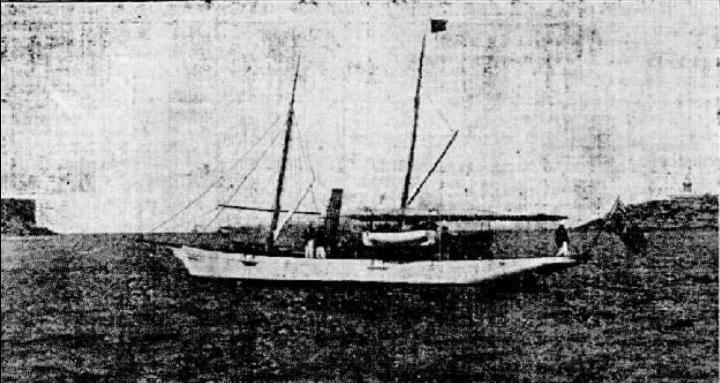
Photo: Mr. S. Hordern's Bronzewing.
but it is distinctly behind the Norman ceremony of the christening of a vessel. Alphonse Karr, in one of his books, gives the, following description of the naming of a fishing boat on the coast of Normandy. The bells were ringing at the village church; the chanting of the priest, the clerk, and the choir was heard; -they brought a crucifix, salt, corn, and holy water. .. The fishermen, -who were standing round the boat criticising ... uncovered their heads and made room for 'the priest and for the godfather and godmother of the ' boat.. '. . . Everyone made the sign of the cross and the priest began to read in Latin, 'Lord, Thou rules the raging of the sea, Thou stillest the waves thereof,' to which came the response of the clerk, 'My song shall be ever of the loving kindness of the Lord.' Then the priest read from, the 'Gospel, 'When Jesus was entered into a ship His disciples followed Him, and, behold there arose a great tempest in the sea, insomuch that the ship was covered with waves, but He was asleep and His disciples came to 'Jesus and awoke Him, 'saying, ''Lord', save us, we perish!' And Jesus saith unto them, Why are ye fearful, O ye of little faith?' 'Then He arose and rebuked the wind and the sea, and there was a great calm. But the men marvelled, saying, 'What manner of man is this that even the winds and the sea obey Him.'' . . .: The priest next walked round the boat sprinkling it with salt,
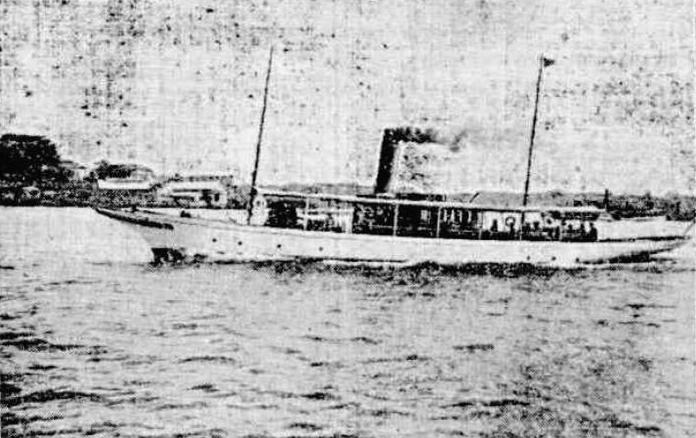
Photo: Mr. T. A. Dibbs Ena
and corn, saying, 'Our help is in the name of the Lord”
The Clerk:- Who has made the heavens and the earth.
The Priest:- Blessed be the name of the Lord.
The Clerk:- From this time forth for ever more
The Priest: Grant, Oh Lord, what is represented by the salt, and by the corn; give us the wisdom that overcomes corruption and iniquity, and bless the work of those who will man this frail skiff.
The priest then, asked who were the godfather and godmother of the boat, and as a second question, What was the name to which the godparents - replied, 'La Mouette’ (the Sea-Gull), sir.'
The priest sprinkled the little bark with holy water and retired, but the owner's wife had placed in his hands a bag of bonbons in which was hidden a little crown .(3- francs), -and the owner gave sweets to the choir children. And as the priest and. his party returned to the church. they sang— 'The .waters rose over my; head, and I cried, I am lost! I called upon Thy name oh Lord and was saved. My help cometh from the Lord who hath made heaven and earth’ And all present again made the sign of the cross. There were sweets for the other children and later the whole party sat dowm to repast of soup, fish, and meat. Cider was the beverage. A merry evening was spent, and when the hour of parting came they sang a hymn to Mary.
All that sounds very strange to us at the Antipodes, yet, with all their simple .faith, those Norman fishermen have been for centuries splendid sailors and the blood of the Vikings runs in their veins. While it is unlikely we shall ever have a ceremony at the christening of a vessel on this side of the world, it may be well worthwhile considering whether our launchings cannot be made more picturesque and more interesting.
APOLOGIA FOR STEAM YACHTING
“I sing the sailor of the sail, breed of the oaken heart,” wrote T.F Day in his “songs of the Sea and Sail” and most sailing men will heartily join in the chorus, but steam has played an important part in yachting and cannot be passed over. It is true that with us it has never been a rival to sail. Steam yachts are more expensive to build and to run, and as we have seen, the class of men who could best afford yachting had withdrawn from it before steam yachts became popular elsewhere. Sailing men are apt to become too conservative; they do not care about asking a man on board unless he is used to yachting or boating; and, as a matter of fact, it is penance to some persons to spend an afternoon on board a small sailing vessel. A distinguished .British General, who had been induced to go for a sail on board a 15- tonner, when it was blowing a black nor'-easter, spent an infinitely more uncomfortable couple of hours than ever he had put in under the hottest fiire; and a well known artist, whose wit and humor are proverbial, confessed that he was out of place on board a 5-tonner. “The skipper shouted to me to let go the lee runner; I told him he must be mad; I never had such a thing in my hands in my life.”
But onboard a steam yacht, those, who are absolutely ignorant of boats and their ways may not only be entertained, but be entertaining. The fair sex in dainty dresses and with colored parasols look well among the guests and the clergy and the laity may be equally invited. The writer does not mean to infer, that the clergy may not be good sports, but it must be conceded that few of them are such masters of craft as the. Rev. Dill Mackay of the Colleen Bawn, and the Rev. J. Cosh, of the Audrey. However, if a clergyman remembers and acts up to the exhortation in Ecclesiastes to 'be not righteous overmuch,' he will be a welcome guest on board most steam yachts, and the writer remembers a very merry trip to the Hawkesbury with a bishop in the party. He was out to make everyone happy; he played a splendid hand at whist, did tricks with cards in which the quickness of the hand deceived the eye, won every game he joined in, forgot his stock when he went to lay the foundation stone of the new church at Wiseman's Ferry, asked for a holiday for the school children instead of asking them goody-goody questions, and was voted the jolliest old sport on board. And why not? Then a steam yacht presents opportunities for flirtation, without the risk of the boom coming across at the supreme moment, and one old steamer-she is still afloat— was the silent witness of many a proposal that would have been made — if made, at all — under infinitely less comfortable conditions on board a small sailing vessel. Those, sweet reader, are the writer's apologies for steam yachts.
SOME STEAM YACHTS
“And above the sullen roar of the breakers on the shore, came the throbbing of the engines as they labored to and fro.” – Paterson.
The Fairy, a beautiful little straight-stemmed screw vessel, with a faire turn of speed, made her appearance in the sixties. She was, perhaps, our earliest steam yacht, but she did not long remain a yacht, and went to earn her living as a ferry boat. In the year -1874, Mr. William Dunn, who has designed and built so many screw steamers, turned out the pretty little Fawn to the order, of the late Mr. James Milson, and the same builder built the Ena for Mr. George Cheeke. The second Ena, 56 tons, for Mr -T. A. Dibbs; and the Northumbria, 35 tons, for Mr. Christopher Newton, both from the same yard, followed in 1884. The last named yacht was a present to a worthy man from his creditors, in recognition of his determined and successful efforts to pay them in full, after he had obtained a legal release. It will, perhaps, be remembered that Mr. Burt, who left Sydney for Fiji in his 26 ton cutter Vivid, mentioned in a former article, without the usual valedictory banquet, also paid in full the creditors he had left behind him.
Mr. Samuel Hordern imported the beautiful Bronzewing from England. about this time; the Hon. R. H. D. White's small yacht, gave way in, 1889 to the White .Star, a fine composite built vessel of 107tons, designed by Mr. Cracknell; and Sir James Fairfax built the Isis, in 1892, on lines supplied by Fife. No race was ever officially arranged, between these boats, in spite of a great deal of talk; but when they met on the harbor, human nature invariably, asserted itself, and their staid owners, did not spare the coal.
The only other steam yacht of any importance that, need be mentioned is the third Ena, 105 .tons, designed by Mr. Walter Reeks, and built by Ford in 1901. But the days of the steam yachts are numbered. The benzine boat, (pardon the plagurisim on Mr. Elbert 'Hubbard’s ‘Benzine buggy')is fast usurping her place.
A FAVOURITE CRUISE
A few -years back, steam yacht cruises to the Hawkesbury were very common. A plentiful supply of schnappers was picked up off Long Reef; a call was made at Barrenjoey, where dear old Al. Black, the local Collector of Customs, if he could not be induced to join the party, under the pretence that he was to find an illicit still in one of the creeks; was press-ganged on board and the yacht was headed for the glorious scenery of the Hawkesbury. What a delightful cruise up the river; what strange old folk one met; and what pretty girls! No wonder a party of young fellows pushed a heavy fishing boat 40 miles against the current to see some of them. History relates that the girls snubbed those particular Lotharios; but still Hawkesbury lasses are not so coy, and there is a legend that and old sailor, who had gone up the river in search of a wife, found a dashing girl standing bare-headed on the bank without any formal introduction, and with very little preface, he proposed. “Wait ‘til I get my hat” was the lady’s laconic answer. What glorious nights, their stillness broken only by the, rustle of the breeze in the growing, corn, or the cry of the curlew. How sweet to row under the trailing branches of the willows and what a dash down the river with the current: Last, but not least, there was . the sea trip on the way home-; the nor-easier gathering up a blue haze on the shore; or the run down the coast at full speed against a southerly, - the spray flying from the bows, and. the engines throbbing rhythmically. But steaming is steaming, after .all, and the true yachtsman -will always be a sailor,' and not a smoke-jack. ; -To 'Be Continued; PORT JACKSON PLEASURE FLEETS. (1907, November 23).Evening News (Sydney, NSW : 1869 - 1931), p. 3. Retrieved from http://nla.gov.au/nla.news-article113898613
Ena I, II and III threads collected by A J Guesdon, 2013.